Freebooter's Fate by Hedningen
Thunder and Doubloons
Original SA postSeeing as Mors Rattus has been doing a wonderful job giving detail on Warmachine and Hordes, I may as well talk about a somewhat less well-known skirmish game. Seeing as I've failed to finish a couple of other attempts at this, I've taken the time to write the entirety of this review up
before
posting anything, thus making it a lot easier to actually finish it. If you want more detail on anything, I'd be happy to provide it, but most of this review is going to be me pasting from my wonderful text document of the complete review.
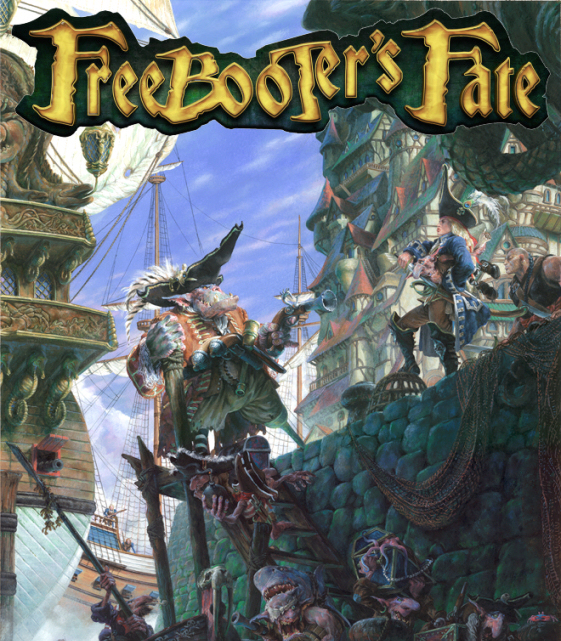
Freebooter's Fate
is the brainchild of renowned miniature sculptor and noted German Werner Klocke, who has sculpted for most of the big names in the minis industry. Notable former employers include Reaper, Games Workshop, Privateer Press, and Wyrd Games, all of whom are considerably more well-known to the world at large. However, back in 2002, he started Freebooter Miniatures to showcase his work. After a while, he and his crew decided that they wanted to write a game based around some of the miniatures that he had designed over the years. Starting as a high-fantasy game that used dice, it was, according to the design notes of
Freebooter's Fate
, 2006 when they thought of using cards for play purposes.
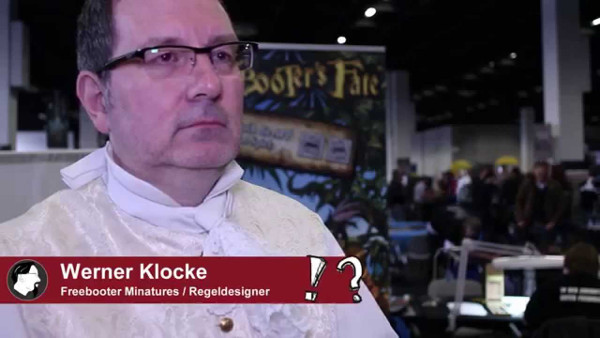
Pictured: Werner Klocke, gazing into the abyss.
2009 was a big year for card-resolution skirmish games outside of the traditional fantasy genre, as it was the same year that
Malifaux
first came out. Unlike
Malifaux
,
Freebooter's Fate
has received comparatively little attention, in part because it's a game that's natively published in German and in part because there's little exposure in the US convention scene; Freebooter Miniatures usually has a large booth at Essen with some gorgeous terrain, but I don't believe they've been to GenCon yet.
It's an interesting case of parallel evolution, but that's beyond the point. Let's talk about
Freebooter's Fate
!
Part 1: Thunder and Doubloons
The book opens with some introductory fiction, set in the world of of
Freebooter's Fate
. Rather than extensive worldbuilding, the world is explained in short excerpts of story in each book, along with stories explaining the story of every model in the game. Things begin – as in any good pirate story – with someone having stolen some treasure. Captain Garcia, of the ship
Galamancha
, is chasing after Captain Rosso, a pirate who has just stolen the pay chest for the Armada's entire garrison.
”Freebooter's Fate 4” posted:
”Of course it was dark, you son of a diseased seal and a slightly manky jellyfish! That's pretty much the point of a midnight raid! Fer Fate's sake!”
As you can see, it's not a game that's deadly serious.
Things soon grow more complicated for Captain Rosso's scurvy crew and the Armada's marines when some of the island's native goblins notice the boats heading towards their land. Goblins are interesting in this game in that they were enslaved by the human colonists who came and occupied their land, seen as savages who were being done a favor by being enslaved. There's some unfortunate issues with this portrayal, but it's an interesting way to have goblins in the game and use some of Werner's interesting sculpts, so we'll talk about it later.
The whole heist goes even worse for everyone when the fourth major power on the island of Leonera gets involved. The Brotherhood, a shadowy organization of mask-wearing assassins, was planning on embezzling a portion of the chest to fund their grand design to reorganize the political shape of the world. They end up running into the goblins, and things seem to go their way, until everyone starts attacking everyone else, and the situation gets so confused that Captain Rosso manages to escape into the jungles of Leonera.
Meanwhile, we get to join our next viewpoint character, Javier, as he first enters the main city of Leonera. Here's where we learn a bit about the world; Leonera is an island in pretty much the middle of nowhere, 50 days sailing west of the nearest bit of organized civilization, the Empire. It's not the most recently discovered island; that would be El Atajos, which is on the route to Hacia Elocaso, where the Empire has founded several colonies in the hope of getting a great deal of those things that are needed to fuel an empire, with an emphasis laid on ”treasure”.
Javier immediately heads towards the pub and learns some distressing news. Rather than being a safe harbor for a citizen of the Empire, the city of Puerto Alto has been renamed Longfall, and a group of pirates, led by Blanche Pascal and several other captains, convinced the Gobernador to enlist them as privateers and renamed the city to better reflect the waning power of the Empire. His night gets worse as he gets drunk, gets beaten by a crew of pirates, and has all of his money and clothing stolen. He wanders through the outskirts of Longfall, desperately seeking the waitress he was hitting on before he was attacked, and extrapolates a bit on the political situation; there's a rebellion going on in the Empire, the King has been in hiding, and there's talk of all sorts of danger in the New World. Even worse, he overhears various people talking about how Leonera has been forgotten thanks to the discovery of El Atajos.
Javier eventually manages to find his feet, and the introductory story ends with him considering his options; he could sign on with the Imperial Armada, or join any number of pirate crews. Longfall is a dangerous place, but it's not without its options for anyone willing to take a risk.
Coming up next time: how this game actually works!
The Rules of Freebooter's Fate, OR, Touching Dice Leads To Pirate Curses
Original SA postWelcome back to this Fatal & Friends of
Freebooter's Fate
, an incredibly pirate-y skirmish game with some gorgeous models and – as I hope you'll see today – some pretty good rules.

Part 2: The Rules of Freebooter's Fate, OR, Touching Dice Leads To Pirate Curses
Games are played with
crews
of around 8-12 miniatures on each side; a learning game can be played with 4-5 on each side, and larger games are certainly possible. When building a crew, players agree on a point total – 300 is a good amount for a learning game, 500 is the typical size, and 750 is suggested for larger games. Rather than points, the hiring fee is in
dubloons
, to represent the fact that you'll need to pay your crew, as no proper pirate would fight without a chance of treasure.
This sections also introduces some designer commentary, given in the appropriately piratanical “Written in Blood!” boxes. These serve to clarify rules, add some flavor and humor to what could be an otherwise dry section of rules, and give some of the notes of the writers. As the first box says:
”Freebooter's Fate 14” posted:
Listen up, ye mangy landlubbers! Some rules are so important that we've written them in blood! Heed them well and they will not just improve your game but also your life! The first and most important rule: Freebooter's Fate is a game; it is supposed to be fun, entertaining, and always fair. Arrr!
The game then explains the special cards used; character cards . hit location cards , Fate cards , and event cards , all of which will get a more thorough examination throughout this chapter.
Character cards should be familiar to anyone who has played these sorts of miniature games – they list all the vital statistics of a character on the field and makes tracking their health a little easier. Each character card contains the following information:
-
Name
– Obvious. The character's name.
-
Crew
– The faction that the model belongs to. We'll talk about them later, but in general, models for your crew can only come from one of these factions.
-
Rank
– The role that the model plays. There are three ranks in the game;
Leader
, which you need to lead your crew and can have only one of,
Deckhands
, who are the rank-and-file and can be hired in unlimited numbers (up to the dubloon value of the game, of course), and
Specialists
, which have more specialized abilities and can be hired depending on how many Deckhands you have.
-
Authority
– Used for morale tests. Not every model has this – generally, only Leaders will.
-
MOV/Movement
- How far a model can move.
-
A/Attack
– How many hit location cards you use in an attack.
-
D/Defence
– How many hit location cards you use when defending.
-
ST/Strength
– The base damage of attacks.
-
T/Toughness
– The base resistance against damage.
-
V/Vitality
– How much damage a model can take.
-
M/Morale
– How brave the model is – used when testing for morale.
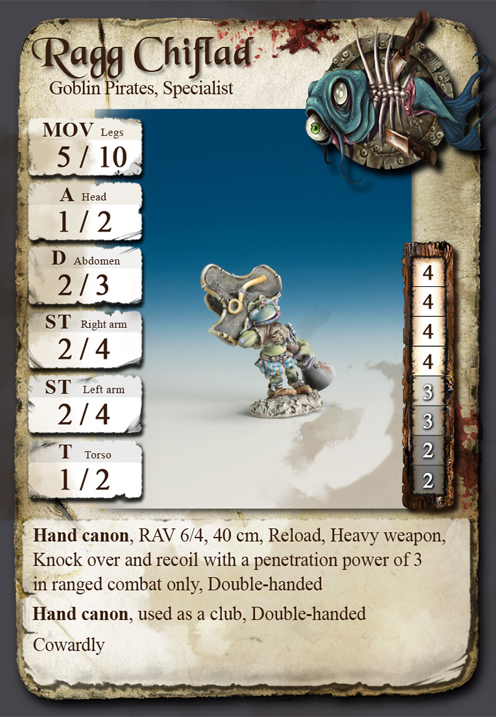
An example card; just look at all that currently-meaningless information!
There's more information on the cards, but it's pretty self-explanatory – everyone knows what equipment is, right?
Then, we get to the explanation of Fate Cards – it's a separate deck that's used for random number generation. Whenever you're checking for numbers, you draw a Fate card and lay it face up, leaving it so everyone can see it, to determine the value. Fate cards can also trigger Event Cards – if you draw a Fate card that indicates an Event card, the player who drew it gets to draw an Event card and add it to their hand. They can be played at any time, and have all sorts of beneficial or negative effects.
Finally, we've got the Hit Location Cards – the most interesting aspect of the game. Each player has six, corresponding to locations that can be targeted on opposing models. Both players use them in attack and defense. We'll cover this process in a bit, but it's a rather interesting way to determine hits.
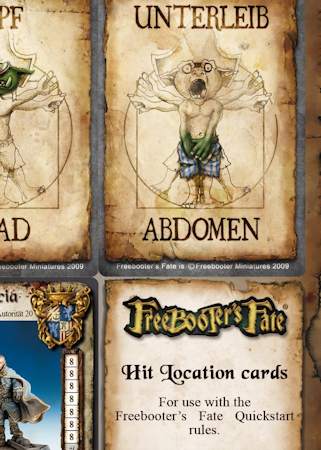
Just one of the several hit location cards!
Next, we get to the game process – it's the familiar “Choose scenario, choose dubloon value, set up, initiative, and play!” style. Models are activated in alternating order – one player activates a model, then their opponent activates a model, and so forth until both sides are out of models they can activate. Real simple.
The real beauty of this chapter is the illustrations (well, pictures with diagrams added) and clear explanations of how models can move – there are rules for climbing, jumping across gaps, falling from high locations, and – of course – swimming. Everything comes with several illustrations showing how things are done, along with edge cases and what to do in case there are rule questions. This is a game that is meant to emphasize movement and positioning, so the rules for it are clear, concise, illustrated with a lot of examples, and very smooth in action. You'd never know that it was originally in German, as it's written a lot better than most English-language rulebooks I've read over the years.
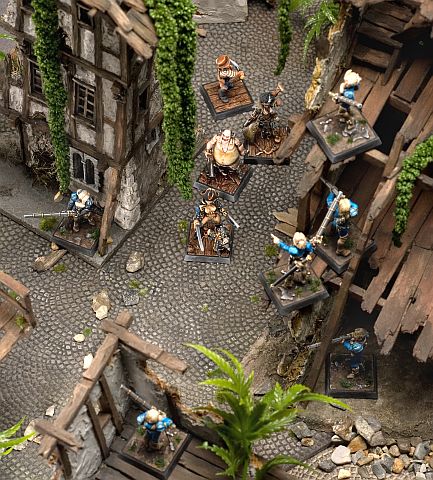
Just imagine some lines and things. This image pops up a lot, explaining line-of-sight, climbing, falling, jumping, and all sorts of other things.
Next up is combat – fairly simple to explain. The attacking player secretly chooses a number of hit location cards that they're targeting, the defender secretly chooses locations to defend, and both players reveal simultaneously. If there's an undefended location that the attacker targeted, the attack succeeds and damage is checked by adding the value of a Fate card to the attacker's Strength, subtracting the defender's Toughness plus a Fate card, and (if the value is positive), dealing that amount of damage. This means that combat can be incredibly lethal – most models don't have a ton of health – but the tactical elements of attacking and defending make it feel better than you'd think.
There's also something that needs to be explained about the stats on the card – notice how there are two values for the various stats? Well, it's possible for models to take a critical hit to a location – the basic method is if the attacker manages to hit two undefended locations on the defender, then it's an automatic critical hit, so long as it does damage. The attacker chooses which of the two undefended locations takes a critical hit, and the value on the right is crossed out, with the model now using the value on the left. This means that critical hits are nasty, playing a huge part in the tactical game of attacking, because you'll generally want to try for critical hits on important locations of your opponent. The changing statistics emphasizes the effect of damage on models, and it's a welcome change to unchanging statistics while a model is an inch from death.
Activating models is simple – every model gets either 2 simple actions or 1 complex action. There's the usual standard actions – moving, attacking, rallying, charging, and so forth – along with some specialized actions that I haven't seen elsewhere, like shoving opponents, breaking down doors or opening locks, and the various methods to scamper along terrain. It's all very logically laid-out, with exceptions pointed out clearly in both the action that causes an exception, as well as in the action that it would effect. There's a lot of tactical options given with the relatively simple system of 2-or-1 action, and things fit together really well.
There's also special actions, which can only be performed by characters with the appropriate traits – things like extra attacks in melee, healing wounds, and backstabbing, designed to differentiate between skilled fighters and simple cannon fodder. Any model that can perform these actions usually has the action explained on its character card, so no need to worry there.
Finally, we get to Traits – little extras that change how a model behaves. There are some universal ones given – things like climbing, being especially tough, or traits given to equipment that a model is carrying – but a lot of models have unique traits, given in their character card. There's some basic variety here, with more added later on, and it does a good job of differentiating models without every one being “changes a number” in some form or another.
Next time – Pirates! Crew overview and characterization.
Untitled Post
Original SA post
Welcome back to this F&F of Freebooter's Fate , the pirate-based skirmish game. Last time, we talked about the underlying mechanics to give an idea of how the game plays. Now that we've gotten that taken care of, let's talk about the first crew available, the Pirates.
In terms of playstyle, the Pirates are a good “all rounder” crew – they're not inherently specialized towards any one style of play, they're forgiving for newer players, and they have a wide variety of Specialists depending on how you'd like to build your crew. On the negative, their lack of specialization means that they're a little weaker when it comes to dealing with crews that are specialized towards it – they can't swarm like Goblins, they can't enter a heavy firefight like the Imperial Armada, and they're not as deadly as the Brotherhood in a melee, but that's hardly a disadvantage when you consider how they can switch tactics to hit those other crews with something they can't handle.
The chapter opens with a bit of fiction to get the reader acquainted with the Pirate's overall goals and attitudes; as one might expect, they've got a pragmatic worldview and are primarily concerned with getting treasure. In the story, an Imperial captain is helping to transport a rather tiresome charge, Señorita Vendaval, whose father has charged him with seeing she reaches her destination safely. Things don't quite go as planned as pirates catch the ship, and after a long verbal battle between Vendaval and the pirates, they invite her to join their crew, much to the relief of the Imperial Captain and the sighs of the pirate crew.
Now, let's talk about the Leaders of the pirates.
Blanche Pascal, the Pirate Queen has a dream – breaking free from the Empire's rule and finding some way to unify the various pirate crews in Longfall. The exchange in government was her idea, and she's hoping that the city's new policy of “Peace between pirates” could extend even further. Far from being an idealist, however, she recognizes that there's not much of a chance of that happening until the Empire is gone. In the story that fills out her character, she's fleeing with some vital intelligence about the Empire's movements and plans over the next few months. She gives an inspiring speech to her crew, which rallies them enough to prepare to fight off the Imperial crew chasing them.
As far as abilities, the Pirate Queen is a solid leader – good authority, fairly skilled in either melee or at range. As far as special qualities, she's got a goblin companion that automatically reloads her pistol, and she's got an extra point of attack in melee thanks to her skill with a blade.
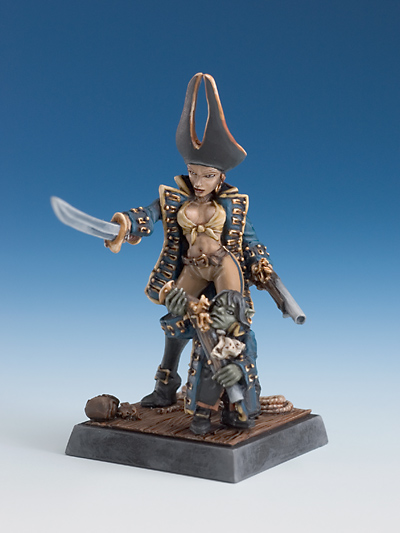
Her model is pretty clearly from before the game was planned, hence the somewhat generic name – I won't point this out every time, unless it's really jarring. Thankfully, all of the models have been sculpted by Werner Klocke, so there's a consistency in the appearance and aesthetic of all the Freebooter's Fate models, so the generic name and design not influenced by the character isn't too much of a problem. There is an alternate model available for her that's a little bit more in-line with her description.
Captain Rosso is a pirate's pirate. He's primarily concerned with three things – getting treasure, cursing at his crew, and getting a good drink. He's our viewpoint character from the opening fiction, where he and his crew were chased by the Imperial Armada after stealing a hefty load of treasure. Having abandoned their ship, Rosso acts like a stereotypical pirate by burying the treasure and making a map out of the shirt of one of his crew members – who then proceeds to grouse about having no shirt for the rest of the little story. Having successfully secured the treasure, they proceed to steal the ship of some goblins. He's a pirate's pirate, through and through.
As far as abilities, he's a little more specialized than the Pirate Queen. He's got two braces of pistols (for less reloading in-between shots), the ability to take a special action to fire a few more shots in a single turn, and quite a bit of health. As far as pirates go, he's much more ranged-focused, and his melee is a bit weaker, but he's otherwise pretty similar to the Pirate Queen.
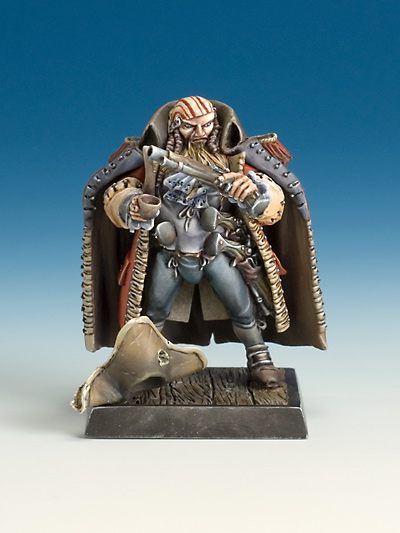
Captain Rosso: The Typical Pirate
Now, for the pirate's Specialists!
First up is Blackbeard , who, while obviously inspired by the legendary Edward Teach of our world, has been changed into a generic pirate for the game. His story is fairly interesting – like most of the pirates, he's been on the edge of things for a long time. Starting out as a dockworker who gained his nickname for his large, black beard – hey, no one said dockworkers are particularly creative – he signed on with a crew, expecting a leisurely life. Things didn't work out, and after a failed mutiny, he was singled out due to his size and temperament. After surviving being keelhauled, he was stranded on an island with the other mutineers, managing to survive and continue his career as a pirate.
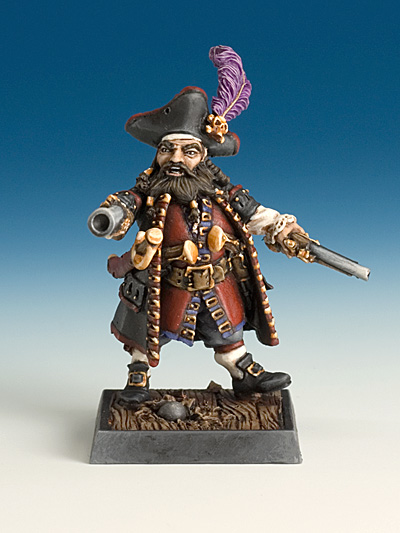
First and foremost, he's a tough bastard – he's got a lot of vitality, and his morale is pretty good. As far as weapons and intended role, he's a prime example of the pirate's middle-of-the-road style; with a pair of pistols and a cutlass, he's equally effective at range and in a melee. Nothing too special, but a solid addition to any crew.
Next, we've got Curly Ann , a former slave with a peg leg. She was captured in a raid on her home village in the jungles of Elsura, which will feature prominently in an upcoming supplement. The story of how she lost her leg is part of her history and her bitterness with so-called “civilization” - it was lost in the raid where she was taken as a slave, and it's a symbol of how much she's lost since being captured. Unlike some of the other peg-legged pirates, she never removes it, wanting to treat it like it's her real leg, and so has no trouble moving around. Piracy, for her, is freedom from the system, and a taste of the beauty of her childhood home.
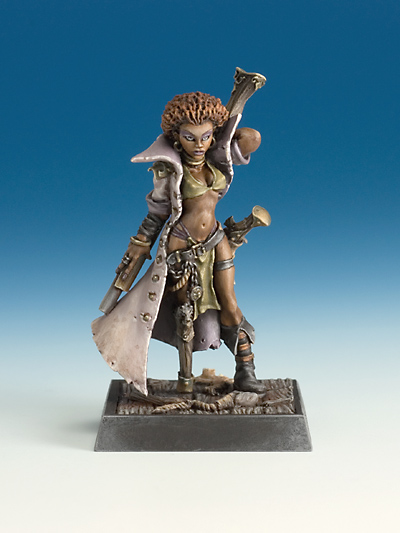
As far as her role, she's got a pretty big rifle with good range and stopping power, as well as some talent in melee. Another generalist – which is something I'm going to get tired of writing by the end of this review.
Long John is yet another typical pirate character – he's the peg-legged, drunken pirate who can't help but tell all sorts of stories as how he's lost his leg. We get two versions of it in this chapter; in the first, he loses it to a well-aimed bomb thrown by a goblin with a shark on its back, and in the second, it's a fanciful tale with a giant three-headed ape. Seeing as he's a pirate and this is a fantasy game, either story could be true.
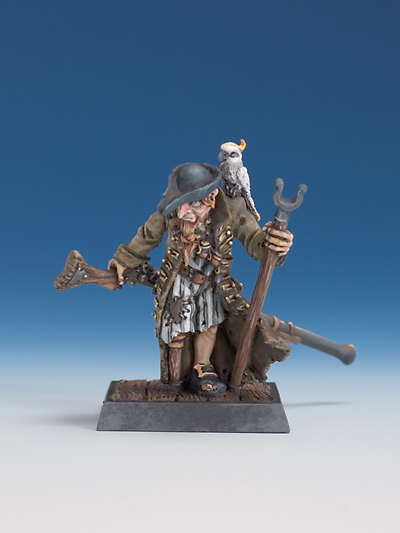
For his role, he's a long-range fighter – thanks to his peg-leg, he moves a little slower than most models, and he's packing a huge rifle. Unfortunately, his melee abilities are somewhat pitiful, but that's the cost of specialization.
The Lady is a symbol of how piracy is a social equalizer. Starting out as a simple shopkeeper's daughter, she signed on with Blanche Pascal's crew to escape her life and live free. While she enjoys dressing well and keeping up her appearance – in clothing far finer than she ever would have had if she'd married young and followed the plans her father set out for her – that's all there as a way to disarm any idiots foolish enough to think that a woman isn't strong. Her introductory fiction involves beating the hell out of some sailors foolish enough to believe that, just because she's a woman, she's an easy mark.
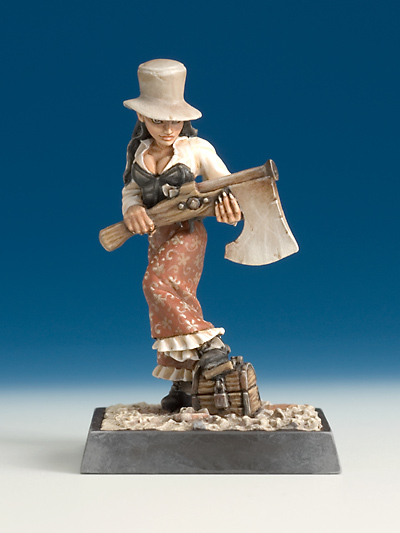
For statistics, The Lady is a damn impressive piece. While she's dependent on not taking any critical hits to her arms to fight well, her pistol-axe is a decent weapon at range and a powerhouse in melee, with the ability to knock down her opponents.
Krud has no illusions about what he is. It'd take several baths for him to be considered “clean”, no woman would ever touch him without a lot of coin to convince her otherwise, and he's not the sharpest knife in the drawer. He's had a rough life – raised with a lot of other children, half on the streets and looking ugly as sin. On the other hand, he'd always been a big lad, fighting in bar brawls and prize fights. A pirate captain notice his skill in tavern fights and, eager to escape his life on the docks, he signed up. Once on the ship, his talent for gunnery was discovered and Krud learned that guns and cannons are wonderful things.
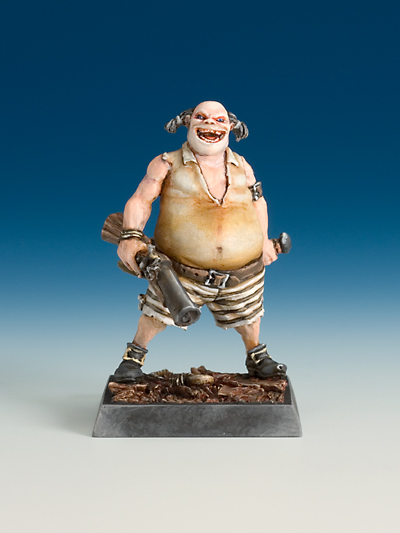
Krud's a tough customer in melee, and he's got a heavy pistol that's closer to a rifle for handling ranged combat. Aside from his equipment, he's close to most of the other specialists we've talked about here.
Mono is a lucky son-of-a-bitch, who joined up as much for his sense of adventure as for the money and women associated with piracy. His little introduction is as much him bragging about his skill and luck as it introduces him – he's a skilled rigger and fighter, as well as a cocky little bastard.
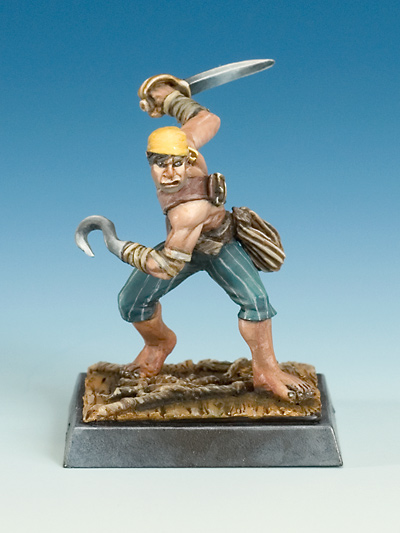
For his abilities, Mono is a pure melee specialist. Rather than going the “tough” route, he's incredibly quick – with better movement than anyone we've seen so far and a trait that lets him scramble over most obstacles with no penalty to his movement, he's there for precision strikes and objectives, rather than bogging folks down in a fight.
Spitfire , whose name used to be Melissa, joined up with a merchant crew to chase after Mono, who had left her after one of his flights of passion. After the merchant ship was ambushed by pirates, she joined them on a whim, and managed to eventually track down Mono, greeting him by beating the hell out of him and then deciding that she really enjoyed the life of a pirate. Taking her name from the huge six-barreled musket she carries, she's another pirate who's out looking for adventure. Her history with Mono also illustrates the nature of pirates – even when they're enjoying life, most of them are fleeing from something.
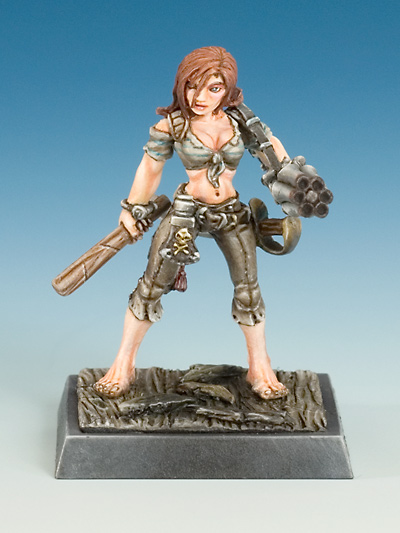
Fairly well-rounded, Spitfire has respectable melee ability, but her real stand-out piece is her six-barreled musket. Unlike most firearms, she can't reload this, but she's got six shots over the course of the game, and can choose to fire extra shots during a turn to increase her accuracy and damage potential.
Now that we've finished up with the specialists, let's talk about the pirate's Deckhands . Rather than character summaries, I'll hit the main types, as these are “generic” characters, rather than people.
Pirates are your basic pirate deckhand – well-rounded, armed with a pistol and knife. Not a lot of special abilities, but they fill out the field. Cuchillo are identical, except for a little bit less health and throwing knives in place of the pistol – they never have to reload, but they have slightly shorter range. Tiradora are your long-range deckhands, with large muskets and decent range. Finally, the Matelot is identical to the standard pirate, except slightly better in a melee with less resistance to damage.
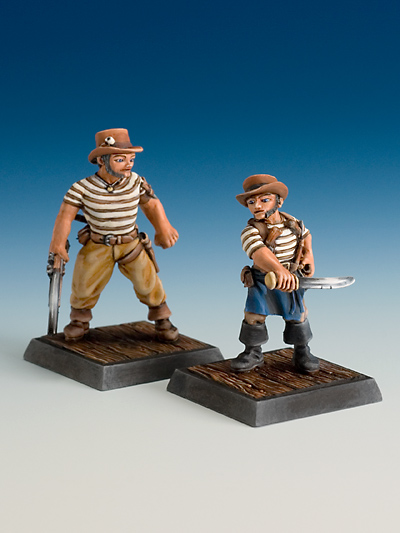
Pirate is on the left, Cuchillo is on the right. Below: Matelot left, Tiradora on the right.
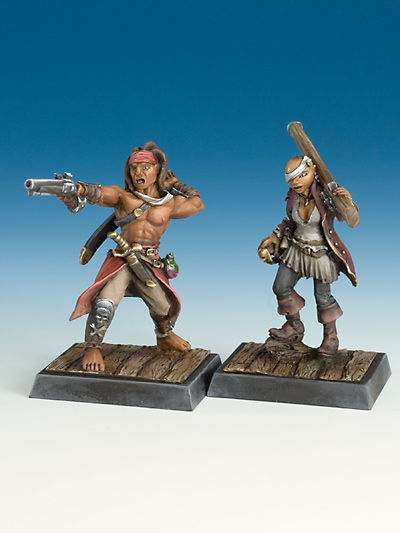
As far as crew composition, you're required to hire one Leader and at least one Deckhand. For every Deckhand, you can hire a Specialist, but if you wish to hire multiples of any Deckhands, you need to hire at least one other Deckhand of another type – so, for example, if you want to hire two Cuchillos, you need at least one other Deckhand of another type.
Pirates are a good starting crew – as you can see, there's a wide variety of options that are flexible, with slight bias towards one role or the other. While they don't have a lot of options for long-range, most of their units at least have options for melee and ranged combat, and they're decently skilled at middle ranges.
Next time – the Imperial Armada!
The Imperial Armada
Original SA postDoresh posted:
Now I wonder how the original version of Dreebooter's Fate reads like. We might have our Arrrs and general sailor terms, bit there's really no dedicated pirate dialect in German, which males dubs of pirate movies a very dry affair.
I honestly can't remark about that element - I haven't read the original German rules, but unless there's been some serious work on the English version, I think it might come across in content more than tone.
On that note, might as well post up the next part of this review.

Part 4: The Imperial Armada
Welcome back to this F&F of Freebooter's Fate . Last time, we talked about the Pirates – this time, let's turn to the side of law and order by hearing about the Imperial Armada, the force of the “rightful” government of Puerto Alto.
In terms of playstyle, the Armada is all about two things – dominance at range with the greatest access to long-range firearms, and a clear chain-of-command that allows the leaders to order models to act out of turn. They've got the greatest access to firearms in the game, and their strategies tend to revolve around forming firing lines, setting a hail of fire against opponents, and charging in when they're softened up a bit. They tend to be a little more specialized than the Pirates, and they have a much greater reliance on their Deckhands for the backbone of their forces.
We again begin with some short fiction that introduces the Imperial Armada and their motivations. Here, we actually get to meet the Gobernador of Leonera, Gobernador Da Capo, as he meets with various important nobles, guild representatives, and the Captains of the Imperial Armada. As the viewpoint is with Da Capo, we learn a bit more about the situation with Leonoera – the Empire sees the issue of Longfall as a betrayal of the pact they signed when they colonized the land. At the moment, the Gobernador is regretting his decision to accept this position; rather than life on a tropical paradise, he has to deal with squabbling guilds and merchants and an Imperial Armada that is spread too thin, losing ground against the natives and the pirates, and mysterious deaths among the nobles. Leonera is in a tenuous position, and the Armada's insistence on holding to tradition is weakening them, especially considering how they reject the benefits of the free port that Longfall has become.
Now that you've gotten a bit more of the political situation, let's talk about Leaders .
Captain Garcia was our viewpoint character for the Armada from the first chapter. He's a textbook military man with a great deal of pride; with Rosso's escape and his own injury at the hands of a pistol-shooting goblin, he's worried that he'll lose his image as the Empire's golden boy on Leonera. He's seen as a living symbol of the Empire's law and order, and he knows that the best way to go about this is through strong orders, a clear chain-of-command, and standing firm in the face of adversity. He'd be boring, if it weren't for that hint of pride over everything; even though he's there to serve the Empire, much of his action is motivated by his own pride.
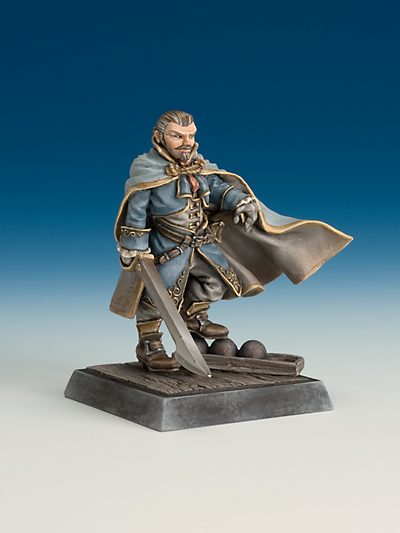
Noble bearing? Check. Captain Morgan stance? Check. Yup, definitely a Captain.
For abilities and role, he's the classic order-shouting leader. He's able to help maintain order within his command radius, rally troops who are fleeing, and send orders out to his troops. He's not exactly a powerhouse in melee or during ranged combat, but his abilities there are primarily there to help him survive on the field. Nothing exceptional, but he's not exactly a costly leader, so he makes a good choice for a firing line.
Captain Leon is the other leader available to the Armada in the first book. He's a traditionalist, a man of iron self-discipline, completely covered in heavy armor. The reason for this is twofold – it makes him look considerably more intimidating, a solid steel soldier of the Empire, and it covers up the horrible burns across his entire body; reminders of the time he dragged himself out of his flagship's powder room igniting while he was in it. When we meet with Captain Leon, he's leading a force of Imperial Marines to drive out some goblins who have moved too far into the town of Longfall; he sees them as a cancer, eating away at the heart of the Empire. He's a man who inspires loyalty by his mere presence, even if it's only from those who think the Empire is right.
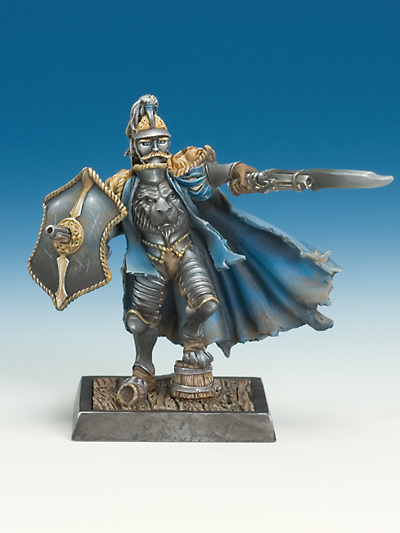
Yup, even his face is armored.
Leon is our first obviously different leader – most of the ones we've seen so far have been close to one another in terms of ability and performance. Not so for Leon – his gimmick is that he's tough as hell, moving slowly but never backing down from a fight and giving the same ability to any of his troops that can see him. On the negative side, with this toughness comes a few disadvantages – thanks to his injuries, he can never be healed during a game. Unlike the rest of the Armada, Leon's ranged capabilities are secondary to his melee skills – he's got a customized sword and shield, each of which has a once-a-game ranged attack available. Definitely an interesting figure.
The Specialists of the Imperial Armada are mostly dedicated to enhancing their Deckhands, keeping the orders flowing, and operating like a well-oiled machine.
Teniente of the Armada has a dream; she wants to become the first female captain in the Imperial Armada, spitting in the face of those traditionalists who believe that women aren't fit for command. By the looks of her, she's got the skills to do it – skilled at command, an excellent fighter, and filled with the pride necessary to serve the Empire. Unfortunately, that pride is also a common error in the tactics of the Armada – much as Captain Garcia, her commanding officer, can never let a slight go unpunished, her pride in her own abilities leads her to make the occasional rash decision. In the fiction introducing her, she's preparing to capture a pirate ship – after all, if she takes command of a ship, she's bound to get her promotion sooner or late. Unfortunately for her, the boarding attempt leads to a few injuries, and she shows just as much of a desire to avenge slights as her commanding officer.
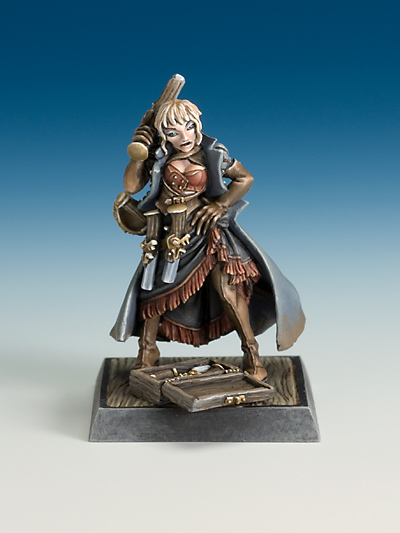
Notice how she mirrors the stance of her superior officer.
Teniente is a Lieutenant, allowing her to take over command duty if she's the highest-ranking officer still on the field. She's also a good shot, able to use her pistols to good effect, and can manage in a melee. Again, she's more suited for command than for combat, but that's the Imperial way.
Sergeant Escopeta is an incredibly cynical, foul-mouthed woman – perfect traits for a sergeant. Committed to making sure her soldiers can withstand the stress of combat, she's all business when it comes to making sure they maintain ranks, stick to proper firing drill, and live to serve the Empire another day. Her introductory fiction has her accompanying Captain Garcia on his mission of revenge against the goblins who injured him – while the Captain immediately rushes off with the marines, she's left to hold the beachead against the charging goblins.
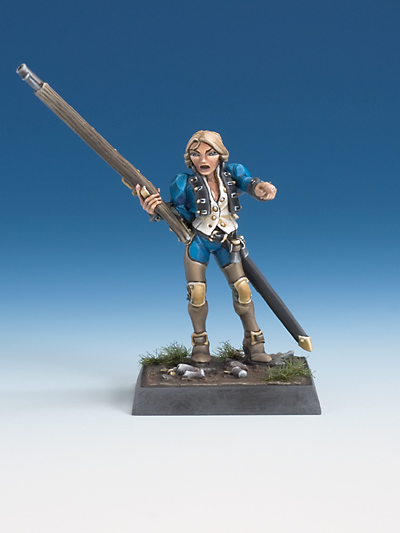
She's got the standard Imperial Mark XII arquebus, a weapon with great range and decent stopping power that's a bit slow to reload, but useful in firing lines. She's also a Sergeant – much like Lieutenant, she can issue orders if she's the highest-ranking officer still on the field.
Tamborino is a generic name for a class of Imperial specialist – it refers to a drummer who helps to relay orders on the battlefield. The particular Tamborino we're introduced to is a son of the nobility who, while interested in music, wasn't particularly fond of “appropriately noble” instruments and so fled to join the Armada. He's proud, even though he's young, and he's hoping to survive his first battle.
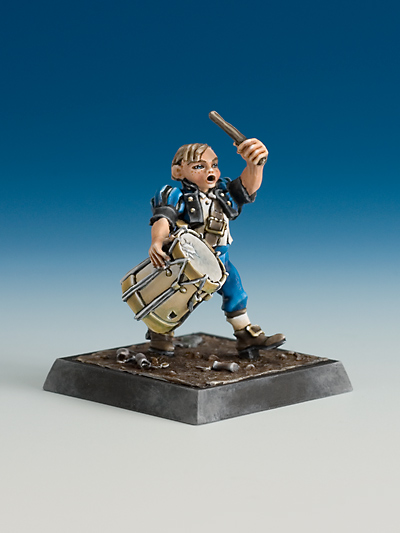
Bonus points for the ropes on the drum resembling drums of the period.
While worthless in a fight, he extends the radius of authority for the ranking Imperial officer on the field, so long as he's still within their command radius. A damn useful skill, especially because it doesn't matter who the commanding officer is at the moment – the loss of the Captain while there's a Lieutenant or a Sergeant on the field means that he's still keeping the troops going.
Torpe is a hero. He saved his sergeant from an assassin's crossbow bolt, heroically leaping in the path and taking a shot to the temple. While he survived, his mental facilities didn't – he'd lost the ability to reload, much less fire, an arquebus, and it had taken every favor the Sergeant whose life he'd saved had to see that Torpe remained a soldier, becoming the unit's mascot. In a desperate skirmish against some goblins attacking an Imperial warehouse, he'd shown that he was still useful – while he couldn't load or fire an arquebus anymore, he recognized that his fellow soldiers could and managed to divert the goblin's assault by handing a loaded weapon to one of his comrades. And so, Torpe continued his service as a mascot and pack mule.
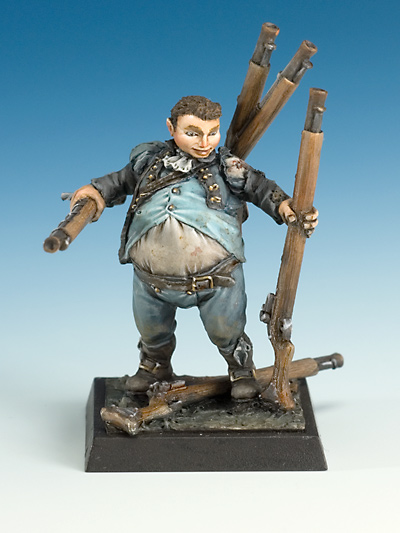
Torpe is fairly useless in combat, but he carries several loaded arquebuses with him. He can hand these out to anyone in the Imperial Armada who uses an arquebus, helping to mitigate their slow reloading speed.
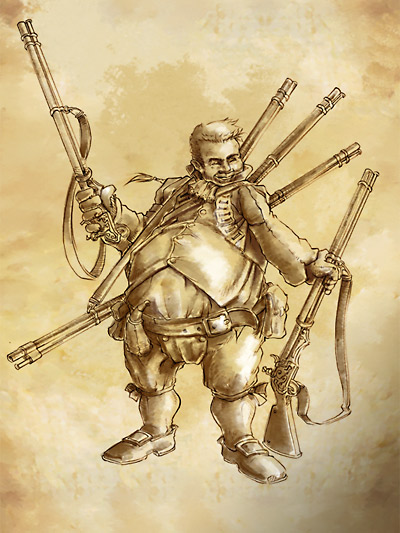
Here's his concept art, showing how close the art is to the actual sculpts.
The Comtessa started life as an attractive village girl named Penelopa living in a small coastal village, youngest of eight children. With her natural charm and beauty, she thought that there was more to life than living as a peasant, and started learning “properly nobby behavior” from the local Don's son, whose hope sprang eternal. After a particularly violent storm, she recovered several boxes of fine dresses, and, seeing a chance to escape, pretended to be a noble survivor of the shipwreck that left those dresses on the coast. In a series of astonishing coincidences, she was accepted as the noblewoman who originally owned those dresses – who was set to wed the Gobernador of Leonera. Thusly elevated, she quickly grew bored of acting as a trophy wife, and decided that a little excitement was in order. And so, that's the story of why the Gobernador's wife is on the battlefield with the Imperial Armada.
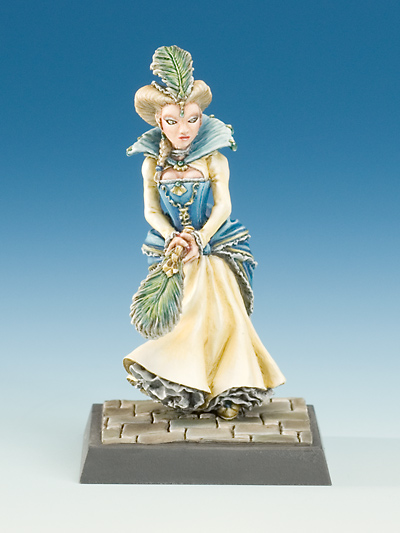
While completely useless on her own, the Comtessa provides a strength bonus to any soldiers within a radius around her, as well as being able to give her favor to a single male character on her crew. She also can be hired with two other Specialists, all three of whom take up only one specialist slot.
The Comtessa's Maid is a large woman. Echoing Pratchett, she's described as having great hair. She's also aware of the tendency of writers to describe such women as having a wonderful personality – rather than having one of those, she's got a club with nails in it, to beat down any threats to the Comtessa's honor. Typically, this involves good hearing, an understanding of the conventions of romance regarding balconies, climbing, and young noblemen, and giving a friendly warning by using the blunt portion of her favorite club.
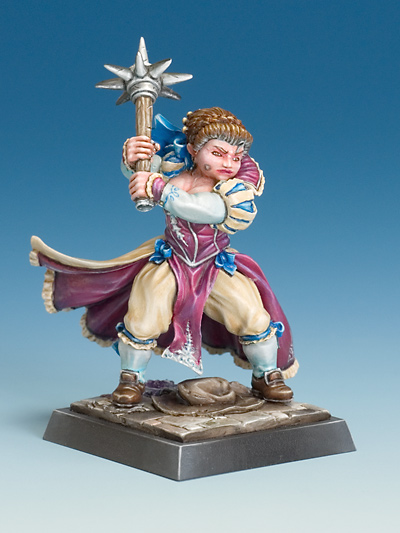
Still a club with nails in it at night.
She's a powerful melee combatant who can knock down most opponents with her club with nails in it. She can only be hired along with the Comtessa.
The Fool was once the head frog-squasher of the Gobernador's estate, a duty deemed highly important after some frogs that were placed in the ornamental ponds on the estate happened to be incredibly poisonous, completely suited to the climate, and a damned nuisance thanks to their croaking. After a particularly harrowing trip into a nearby swamp that had been colonized by these frogs, something unspeakable happened to the Fool – and so he lost his mind, seeing frogs everywhere and proclaiming that he was the Comtessa's sworn protector. Taking pity on him, she kept him on and was made the household fool.
.
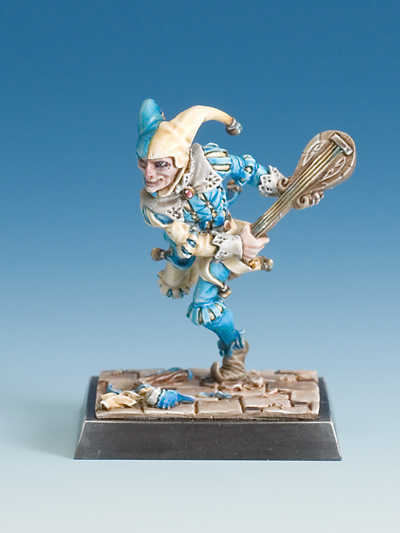
The Fool is barely competent, but so long as he's near the Comtessa, he throws himself in the way of any harm sent her way. Much like the Maid, he can only be hired along with the Comtessa.
The First Mate is a link between the officers and the troops – after all, it wouldn't do to see a gentleman consorting with those rough and tumble sailors. Promotion is often fast, coming after battles that see heavy casualties, particularly those of the previous First Mate. The particular First Mate we learn about is José Maria, a former ditch-digger, whose promotion was somewhat reluctant and immediately came with all of the thankless duties of the Armada – mostly scrubbing, leading drills, and being the link between those out-of-touch idiots at the top and the real workhorses of the Armada.
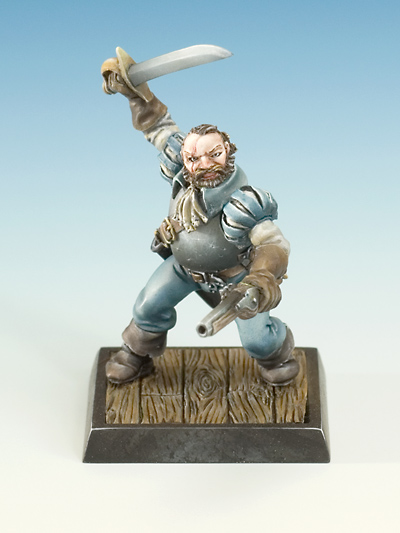
For abilities, they've got the Sergeant trait, talked about under our last Sergeant, and are a little more tilted towards melee combat, with a back-up pistol to ensure that they can manage to survive if they're at range.
The Deckhands of the Armada come in two varieties. Arquebusiers are great for long-range support, carrying the Mark XII arquebus, but aren't too good in a melee. They also have the greatest number of variant sculpts available for hiring.
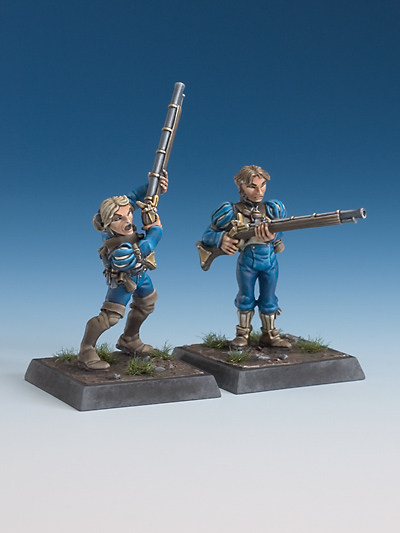
It's almost like they knew the Imperial Armada would love hiring a lot of Arquebusiers.
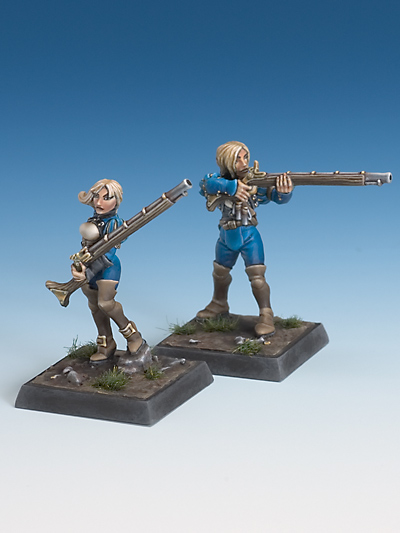
Marines are the other backbone – used for boarding actions, they're packing an axe and a knife. Both are there to fill specific roles, and they're good at it - specialization is key with the Armada.
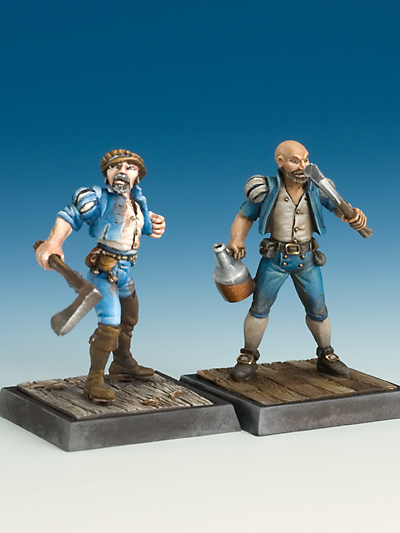
Rum is apparently standard-issue.
The rules for hiring an Imperial Armada crew are the same as for hiring a Pirate crew, except for one key difference – they don't have to change the type of Deckhand they hire, so it's perfectly legitimate to fill your crew with Arquebusiers and the necessary command structure. While you'll be a little lacking in terms of melee ability, there's a lot to be said for withering rains of gunfire.
Next time, we'll be talking about one of the highlights of the game - Goblin Pirates !
Goblin Pirates
Original SA postTraveller posted:
While the game seems to be actual fun, that's a lot of fanservice on the female sculpts. Also, "Lieutenant Lieutenant" and "Sergeant Shotgun" are terrible names. Is this how German players feel when they read bad German in Warhammer Fantasy?
Yeah, I'm not gonna try and defend the sculpts here. While I've seen some folks make the defense that "Oh, it's meant to be silly and play with old genre conventions!", I've always found that a little weak - we don't really need more fanservice-sculpts on minis. Werner Klocke, while a talented sculptor, is still stuck in some of the 90s design trends for female minis and could use less fanservice-y sculpting. I'd say it's gotten a little better in recent years, as there's some variation in body types and there's less gratuitous cleavage, but the fact I even need to talk about this stuff shows that there's still a long way to go.
Either way, time for a little more seafaring stupidity!

Part 5: Goblin Pirates
Welcome back to this F&F of Freebooter's Fate ! Last time, we talked about the noble Imperial Armada, and today, we'll be learning about the next crew: the disorganized, oppressed Goblin Pirates.
As far as playstyle, the Goblin Pirates are all about weird gimmicks, swarm tactics, and hilarity. While they're goofy, there's a serious edge to their struggle – as mentioned earlier in the review, goblins were seen as uncultured, savage barbarians with no culture of their own, able to learn only the simplest of tasks and requiring the guiding hand of those charitable humans willing to take them in. The goblins, on the other hand, were fast learners – intelligent, albeit somewhat cowardly due to their small size – and longed for freedom, eventually rebelling against their slavers and showing that they were as skilled as any human.
In the fiction that leads off the chapter, we learn a bit about the history of Goblins in this world; discovered in the new land of Elsura, they were brought back as slaves, and it was seen as a status symbol for the nobility to keep them as slaves, in part because of their exotic nature and strange behavior. However, a rebellion spread throughout Leonera, and they soon stole ships, weapons, and started acting as pirates. The Cazador – our viewpoint character, a sort of inquisitor for the Empire – has captured one of these goblins pirates, and is about to torture him for more information, but his secret office is broken into by a swarm of goblins, looking to rescue their crew member. The arrogant Cazador is captured, and the goblins flee, successful in their mission to free their friend.
Goblins all have shaky morale – it's one of their universal traits. However, they see the value of strength in numbers, and so long as there are other goblins nearby, they gain a bonus to their morale. Leaders don't benefit from this, but they have some bonuses of their own. So, let's talk about the Leaders of the Goblin Pirates!
Malo Gordab isn't a goblin. He's an orc, who washed up on the shore as a child and was raised by goblins. Far bigger and stronger than the goblins, he was a natural leader – unfortunately, the normal intelligence of the goblins wasn't found in Malo, and he was often taken advantage of by those quicker-witted goblins around him. Still, they respect his strength, and he hopes to someday find out where orcs come from – he reasons that, because goblins make more goblins, there must be other orcs out there somewhere to make more orcs.
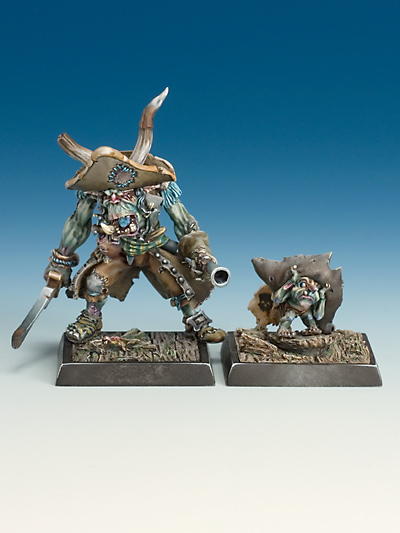
Malo and Bajo. Go, tiny hat goblin!
For abilities, Malo is an absolute monster in melee. While he's not particularly great at giving orders thanks to his slow wits, he makes up for it with his abilities as a fighter. Equipped with a pistol and a sword, he's got the classic pirate loadout, right down to his fancy hat, named Bajo .
Bajo is a Specialist who is automatically hired along with Malo Gordab, costs no dubloons, and doesn't take up a specialist slot. He's a tiny goblin who hides in Malo Gordab's hat. Malo really likes Bajo, especially because Malo likes his nice hat, and he tends to react violently whenever anyone endangers either Bajo or his hat.
As far as abilities, Bajo can come out of hiding to support Malo, getting placed next to him and providing a bonus in melee. He's pitifully weak – utterly incapable of combat – but generally, if Bajo is out, then that means Malo is in melee, which means there are more pressing matters at hand for the unlucky combatants.
The other leader of the Goblin Pirates is Cap'n Ulgat , one of the oldest living goblins. Normally, when a pirate grows too old, they're cast out from command because they can't survive the rough life of a pirate. Not so for Ulgat – he's so old that he can barely move, instead getting pushed around in a little boat with wheels on it that another goblin needs to maneuver around the battlefield. However, Ulgat's got a legend associated with him – he's supposed to have a wondrous treasure, which he tricked Malo Gordab to obtain. The value of the treasure is so great that goblins are more than willing to serve him, in the hopes that they'll be the ones to finally get his treasure. That is, if the treasure actually exists – no one's ever seen it, Ulgat denies that it exists, and the story came from a combination of rumor and Malo, who is so stupid he hasn't figured out that the cunning old goblin in the boat is the same as the young goblin who tricked him years ago.
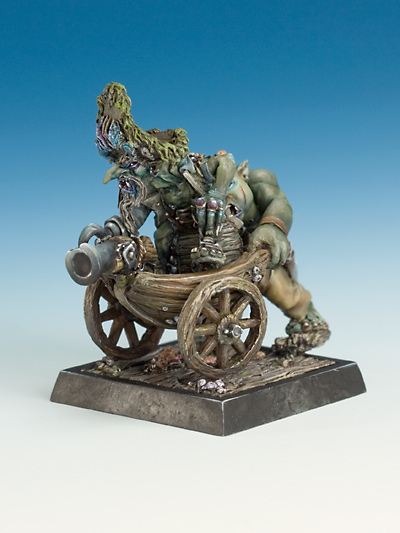
Cap'n Ulgat is fairly weak in a melee, but he's got a rather impressive cannon mounted on his little cart. It can only fire in a straight line, but it reloads quickly and is comparable to some of the high-powered weapons of the Armada or the Pirates. His real strength lays in his ability to inspire and order around his crew – the lure of his treasure buffs up goblins around Cap'n Ulgat, and he's got a good command radius.
Goblin Specialists are a unique lot. There's a lot of varied abilities among them, and they tend to pay reference to media in a far more blatant fashion than a lot of the other crews.
Moby Dugg is a feared Goblin pirate. Back in the day, he worked with the “hairies” - goblin slang for humans – and is most well-known for his tangled history with the pirate Long John. The two worked together to steal a rather valuable treasure from the Imperial Armada, but Long John, drunk on rum, decided to betray Moby Dugg, tossing him in the sea. Dugg managed to take a chunk out of Long John's leg, but the boat was going too fast for him to catch up – especially when the white shark had caught him. He lost his leg to the shark and washed up on an island, barely alive. From that day, he swore he'd catch the white shark that had taken his leg and Long John. The shark was easy enough – he skinned it himself, and wears it to this day, but he's still waiting for his revenge against Long John, saving a bomb just for him.
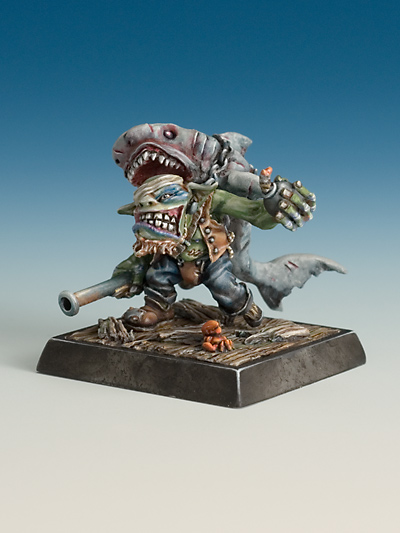
The first of many stupid jokes and references.
As far as abilities, Moby Dugg has a peg leg, which slows him down a bit, but is fairly tough for a goblin. He's armed with a pistol and a single bomb, which he can toss for some serious damage. While he's not the best melee combatant (few Goblins are, really), he's got his tricks.
Revlugg was born a slave. His slave name was Pedro, and he was seen as nothing more than a witless drudge for high-society fops to feel sorry for. That is, until he was ordered to present a pair of guns to a trick shooter – he'd seen guns before, but now that he was so close, he had to try it himself. After thoroughly disrupting a garden party and fleeing, he swore he'd become a renowned gunfighter, free from the hairies' slavery.
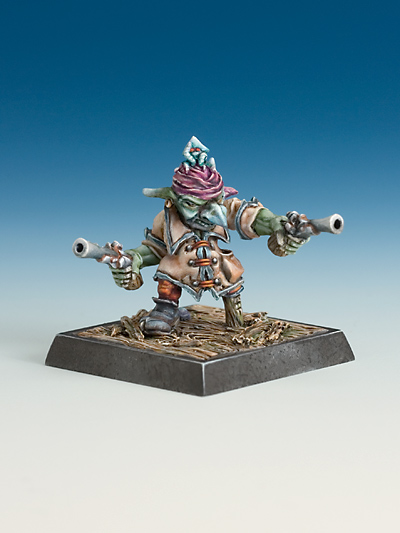
Revlugg has a lot of pistols, and is a fairly good shot with them. His peg leg hinders his movement a little bit, but as he's primarily interested in ranged combat, that's not too much of a hindrance for him.
Momma Cebada was once a slave, starved and mistreated by the humans who kept her and her sister. Together, they lived in the kitchens of the estate in Ribalta, carefully watching the doctor and the cook, learning whatever they could and occasionally stealing medicine. When the rebellion hit, they led their fellow goblins on a flight from the estate, traveling through jungles and on boats, forever hungry, until they finally managed to find other free goblins. She hates when food is wasted, thanks to her memories of her time as a slave.
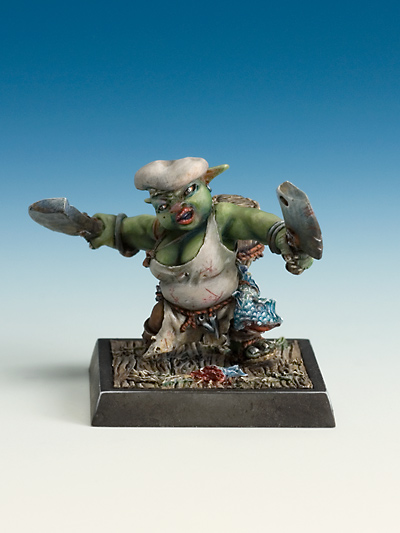
She's a decent fighter in a melee, but her movement is a little slow. Her real value, however, is her ability to heal the wounds of her fellow goblins. She also gains a bonus when her sister, Cucaracha, is on the field and still alive – they've known each other for so long that neither one wants to embarrass themselves while their sister is watching.
Cucaracha is Cebada's sister, and like her, she was interested in learning the art of the doctor who they secretly watched. Whereas Cebada was respected for her skills, Cucaracha is feared – when the unrest broke out on the manor where they were kept as slaves, Cucaracha's man was killed by a human who was seeking to steal the meager possessions of the goblins. She poisoned the human, and has been a little unhinged ever since – unlike the cowardly goblins, she's lost all fear thanks to her work with poison.
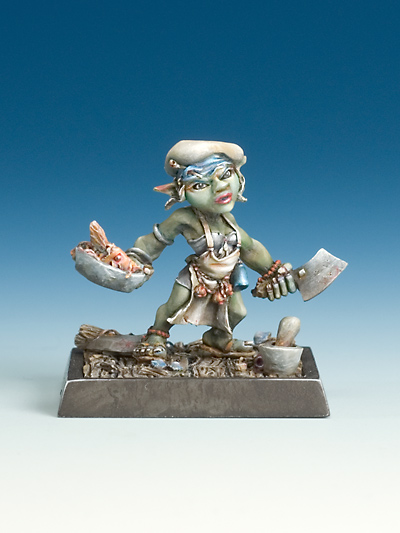
She's got access to throwing knives, and is a fairly competent combatant in both melee and at shorter range. While she doesn't have the goblin's usual shaky morale, she's also unwilling to take orders and doesn't gain the usual benefits that goblin pirates gain through numbers. All of her weapons are poisoned, and she can poison weapons for her allies. Like Momma Cebada, she gains a bonus if her sister is in the crew.
Pegarata comes from a long line of expert goblin hunters, and he's a bitter disappointment to the rest of them. Rather than stay home, he decided to join one of the many pirate crews leaving Elsura in search of adventure, and he's loved the life so far. Especially because he can practice the age-old family trade on the rats in the ship. With his giant axe, he's feared by rat, goblin, and human boarder alike.
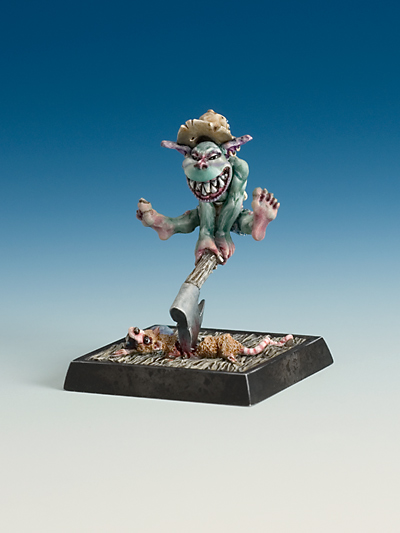
Kills rats dead, but still with a creepy smile.
Pegarata, while fairly fragile, has a rather impressive axe. He's good with it, too – one of the strongest melee combatants that the Goblin Pirates have, with the ability to knock over opponents. He's also damn good at catching rats – he automatically succeeds at any test to catch or kill a rat, which is surprisingly useful in this game.
Bolgod and Golotag are brothers, always hired as a team. They're best described as “nasty”, even by other goblns, as they love nothing more than injuring helpless enemies. Unfortunately for everyone currently living, the only thing they love more than that is explosives. Thanks to their remarkable skill with gunpowder, they've blown up everything from entire ships to small fortresses, and the sight of a pair of goblins giggling while a fizzing barrel rolls closer has led to whole new avenues of cursing being developed.
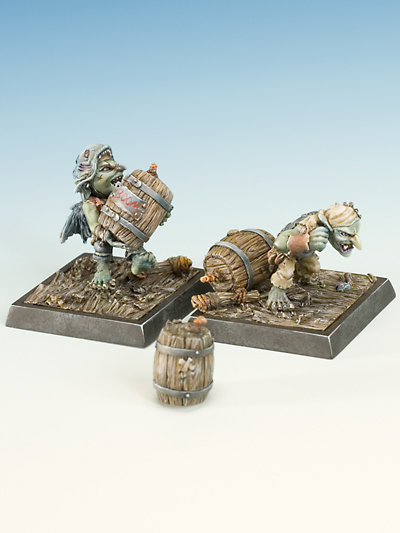
If it isn't obvious, their gimmick is exploding barrels.
As far as statistics, they're identical, aside from Bologod being left-handed. While useless in a melee, they both come with a large barrel of gunpowder they can light and either roll or carry. It's highly unpredictable, can have a truly magnificent blast radius, and is practically suicide to use. Each brother gets a single keg, and they can do a lot of damage with them.
Hueso Narg is a brilliant goblin. He's incredibly skilled with clockwork and other inventions, and he wears his greatest invention with pride into battle. The idea came to him when he was sitting on the beach, watching the shells of giant crabs wash up on the shore. He'd decided, then and there, that he'd build a suit of armor from one of these shells – the pincers worked via clockwork, and the shell protecting him from his opponents. It took several expeditions – and quite a few assistants – for him to find an appropriately-sized crab, and long hours in the workshop reinforcing the armor, preparing the clockwork, and testing the machine, but it worked.
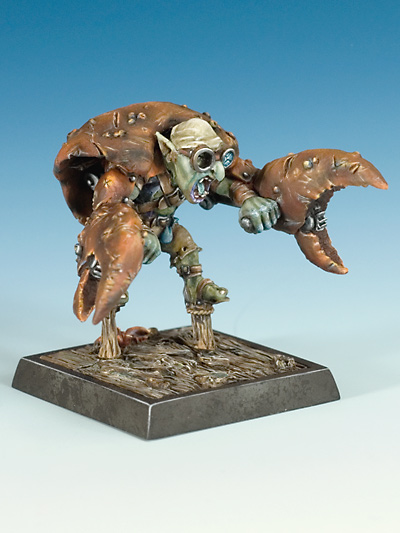
The one time I used him, my opponent wouldn't stop talking about attacking his weak spot for massive damage.
Hueso Narg is slow, but heavily-armored and deadly in melee. He uses his clockwork-powered crab pincers to grab opponents, pummeling them to death with them, and the heavy crab shell makes him tougher than Malo.
Goblin Deckhands are pretty basic. The Mariner comes with a pistol and a boathook – they're professional, albeit cowardly, and they're used to working on ships. A Delero was born a slave, and they've been mistreated so badly that they're broken down inside. Despite having trouble learning blackpowder weapons, they're still aching to get revenge on the hairies, and the hard work they were forced to do means they've got some good muscles on 'em. Geezers are old goblins; they're smart, tougher than regular goblins, and are used to surviving despite the best efforts of the hairies. They're tougher than other types of goblin deckhand, and they've got a pistol for range and a sabre and shield for melee.
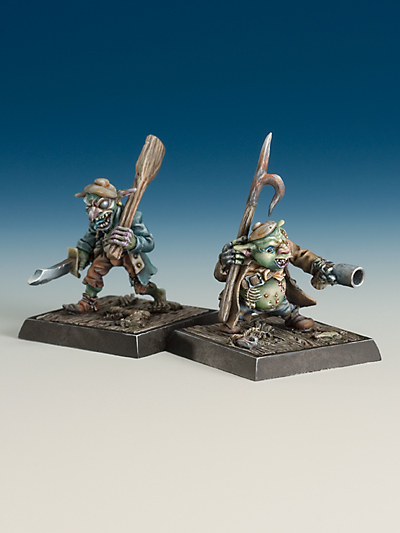
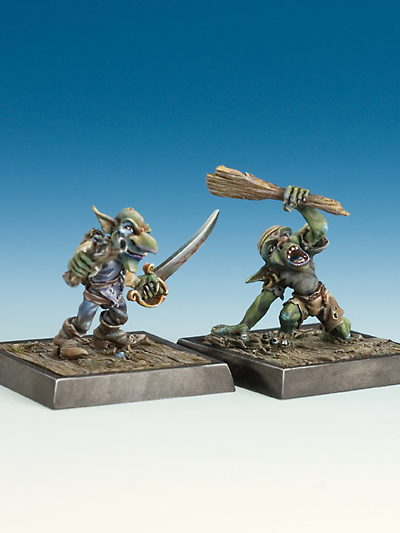
Generic goblin deckhands! How exciting!
Goblin crews follow the same rules as Pirate crews for hiring.
I mentioned earlier in the review that the role that the Goblins serve in the game – standing in for slaves in the real world – is a little hard to swallow, if only because it validates some of the rhetoric used for taking slaves in the first place by making them literal “others” to the humans, portraying them as “crafty” and having them mimic human culture while talking very little about their own culture and language. Still, I think I might be looking a little too deeply – if someone has any thoughts about this, I'd love to hear if I'm just talking out my own ass and reading too much into a minis game about pirates.
Next up; the Brotherhood!
The Brotherhood
Original SA postWelcome back to this
F&F
of
Freebooter's Fate
. Last time, we covered the goofy Goblin Pirates in all their swarmtacular glory. Today, we'll be looking at the
Brotherhood
, a group of shadowy, mask-wearing assassins.

Part 6: The Brotherhood
As far as playstyle, the Brotherhood is all about melee, surgical strikes, and having very powerful specialists. They've all got excellent mobility, they are exceedingly deadly in melee, and they have a ton of access to poison and some unique weapons. On the negative side, they're somewhat fragile and have little access to any ranged attack – the Brotherhood, as fits their stealthy nature, refuse to use any gunpowder-based weapons.
The story that starts off the chapter is less of a narrative and more of a description of the Brotherhood's goals and ideals. Far from being hired assassins, the Brotherhood is an idealistic organization – fifty years before the game's current timeline, King Pelagio discovered the island of Leonera and set it as a shining jewel of the Empire. He was an idealistic ruler, who sought to bring universal freedom and enlightenment to the world. He died without leaving an heir, and since his death, rumors that his mistress, Tamina, bore him a son in secret have persisted. The Brotherhood exists to return the throne to him – or so it's said. No one really knows how they started, who is in command, or even why they do what they do – all that's known is that there's an organization that forcibly recruits citizens, undermines what they see as corruption, and leave more questions than answers.
Obviously, there's not a lot of clear identities for characters in the Brotherhood. Hell, the organization itself doesn't know what it's doing half the time, as it's organized into cells. The goals are supposedly for enlightenment, freedom, and a new golden age, but they're so contradictory that it's hard to tell what they're doing. So, let's talk about the
Leaders
of the Brotherhood.
The
Master Assassin
is known only by his mask, which changes at different times. He's described as taking part in the carnival of Puerto Alto, on the Night of the Red Death. A woman, preparing for an amorous interlude with a noble, catches sight of the masked assassin as he kills her intended lover, a man lobbying for political change. Catching up to him, she rips off his mask, only to reveal another mask beneath it. Obsessed, she looks for him every year, at the masked ball, eventually recruiting her to the Brotherhood.
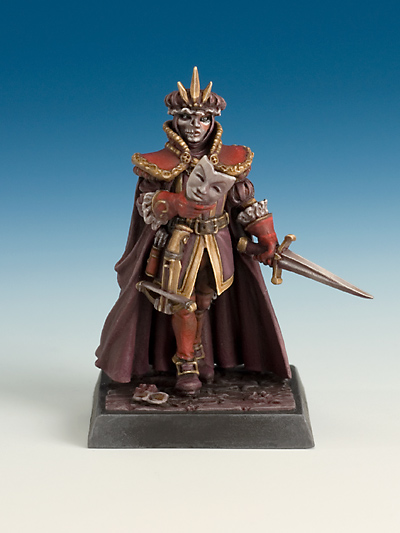
As far as roles, the Master Assassin is a skilled leader – which doesn't have much of an effect on the Brotherhood, most of whom can't take orders – and a ridiculously powerful combatant. He's one of the few members of the Brotherhood with a ranged attack – a crossbowpistol – and all of his attacks are poisoned. However, his most notable ability is Shadowrun – a charge that allows him to essentially teleport between pieces of scenery and get a bonus to his attack. In general, if you're not shadowrunning with the Master Assassin, you're not using him correctly.
The
Queen of Shadows
is one of the few members of the Brotherhood who we learn the real name of – she is Lady Guerina, who understands the dual nature of her ideals. She plays the society lady, but her real world is in the shadows, and the mask that she wears is her true face. In her introductory fiction, we see her prepare for a mission, leaving a ball to kill a foolish noble who is looking to leave Longfall, taking his business elsewhere and leaving his workers to starve. She's a ruthless killer, one who knows that anyone who ushers in a new age on tides of blood is doomed when their idealistic world is created, because they can't exist in it.
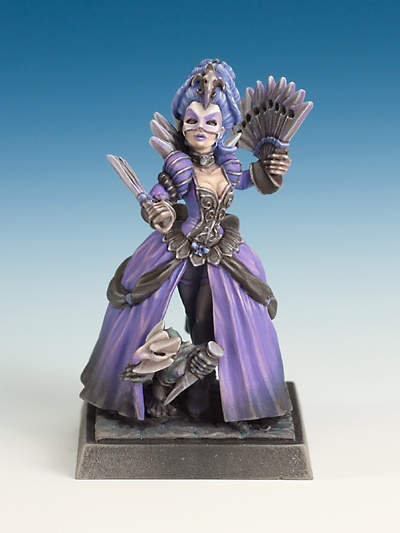
The little dude has no effect on her abilities, is never mentioned in the prose, and is just kinda "there".
As far as abilities, she's a monster in melee, attacking with a pair of poisoned war fans. She's also got access to the usual leadership abilities – which are, again, practically useless for the Brotherhood's pack of loners – along with the ability to attack with the kiss of death, which renders her opponent helpless. Without any ranged abilities, she needs to be in melee to do any real damage, but she's a hell of a force once she gets there.
Now, to the bread and butter of the Brotherhood – their
Specialists
. A lot of them are fairly similar to one another, as there's a winning formula in their abilities, but there's some key differences depending on the models.
Apagado
, wearing the traditional bauta-and-tricorn of the Carnival, muses on the transience of life after killing a young woman, Allegra. He wonders what the point of this all is – if the Brotherhood's mission is even the same one, whether these tasks have anything to do with what they've been doing. He wonders if he's hallucinated the entire Brotherhood, using it to justify his stalking and killing of random citizens. Finally breaking free of the scene when the young woman's brother comes upon her body, he heads off into the night, thinking deeply about everything he thinks he knows in gratuitous purple prose.
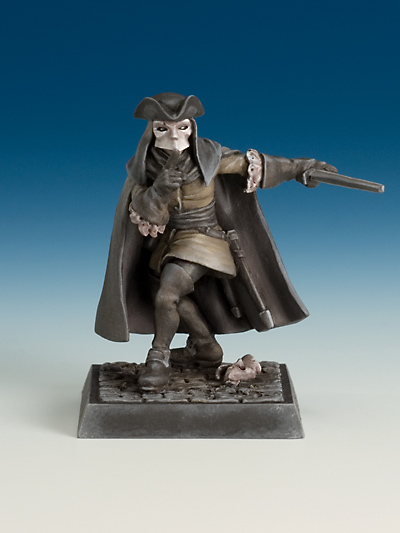
He's the basic model of the Brotherhood Assassin – poisoned daggers, stealthy, good movement, and better at sneaky attacks than a straight-up fight.
Trucco
is stalking Blanche Pascal, seeing her as a symptom and symbol of the rebellion against the restoration of the true crown to Pelagio's bastard heir. He nearly manages to get her, before taking a knife to the side. Unfortunately for Pascal, he is so devoted to the mission that he continues following her, thinking of himself as a great hero.
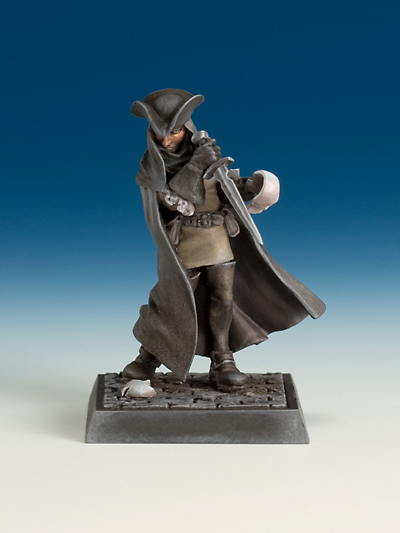
Identical to Apagado, except for having access to throwing knives and a little less strength than him, he's a good addition to a Brotherhood crew.
Bonaccia
sees herself as a dancer, announcing the return of the true heir of Pelagio to Longfall, a world where she will not be needed. It's all melodramatic and poetic and twisted, just like the other two nearly identical people before her.
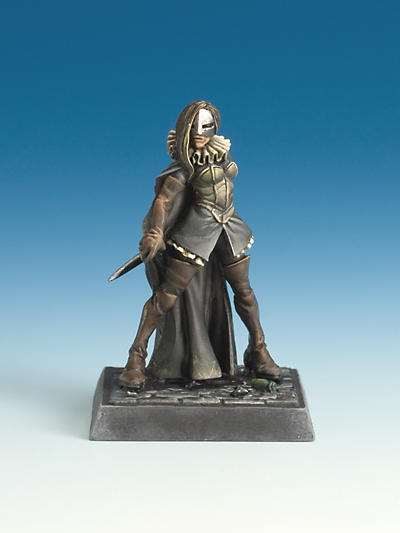
That ruff is pretty great.
She's slightly weaker than Apagado and Trucco, but she's more skilled in combat. I really wish I had more to say, but they're really close to each other.
Fith'Aarch the Spider
is where things start to get interesting. We started with the idealists, and now we're getting to the folks that work for the Brotherhood because they're too unhinged to work with anyone else. Fith'aarch loves poison – he loves it a lot. Most of his backstory is him talking about how much he loves it – in this little vignette, he's working on assassinating someone, not because he is necessary for their Great Work, but because the man had the temerity to survive being poisoned by him before. A creepy bastard, he evaluates everything in terms of how good it is as a poison, and considers anyone who creates antidotes as a conspirator against his one true love – poison.
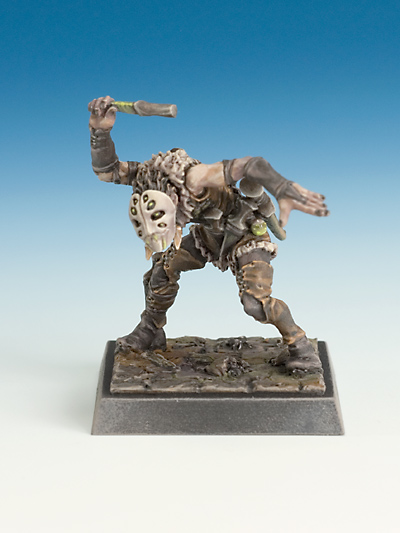
That mask is just so damn goofy.
His gimmick is, obviously, poisoned weapons. He's got access to throwing knives, along with a heavy dagger for melee, but his real advantage is his frankly ridiculous speed, along with his ability to easily clamber over obstacles and an increased defense against ranged attacks.
Romerto the Strangler
is unique among the Brotherhood in that he doesn't wear a mask. That's because he's never left any witnesses alive to know that he works for them. The only one who knows anything about Romerto is an unnamed female friend of his, who sees him as a man out of time. Once, he would have been a noble knight on the battlefield, a hero to the people. In Longfall, he's a serial killer, strangling victims for his own pleasure and killing those targets that the Brotherhood gives to him. The man that this woman is telling the story to also learns why this woman is betraying Romerto's secret – because he's already on the way to kill him, and that's the only time she's allowed to ease her burden.
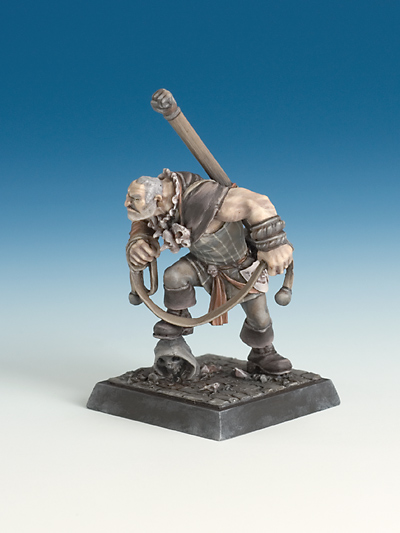
Surprisingly enough, he has no ability to actually strangle anyone.
Romerto is a tough bastard – slower than most of the Brotherhood and without their usual sneakiness, he instead has serious brute force on his side. He uses a warhammer and a meteor hammer, which has the ability to hold targets in place and set them up for his deadly warhammer, and he's got some serious strength behind his blows.
Miedo a Morir
is perhaps my favorite Brotherhood specialist. The stilt dancer is known mainly in tavern legend, and his story is told by a drunken pirate, looking to get some cups of rum from his listeners. He tells the story of how he and his crew were chasing a few goblins into an alleyway, when the stilt dancer came upon them, fearsome long-beaked mask on his face, wielding a scythe and seeming to be the spectre of death himself. Before the pirate could think, his two friends were already dead, and he was running away – one of the few men to ever survive an attack from him.
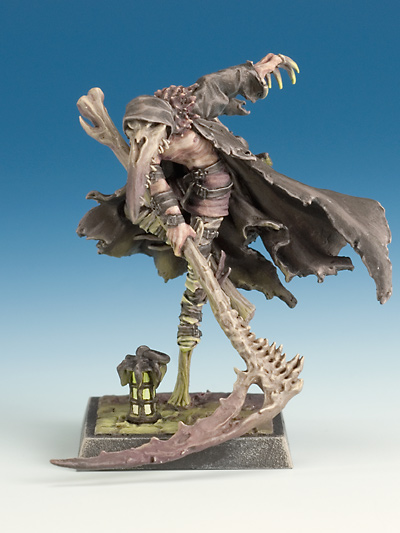
I fucking love this mini, even if it's a bit of a nightmare to assemble.
His gimmick is incredibly fast movement that ignores terrain, along with the game's first instance of forcing morale tests whenever he attacks. He's a little fragile, but then again, he's a ridiculous stilt-walking assassin dressed like death.
Bella Cigna
is one of the few members of the Brotherhood who gets an actual character history. A former circus trapeze artist along with her husband, Adamo, they were known as the King and Queen of the air, famed for their skills. At night, they spied for the Brotherhood, using their acrobatic skills to help peacefully steer the city of Longfall to a brighter future. By day, they lived as artists, carefree and joyful. That is, until her husband's untimely death – unwilling to accept his fall as an accident, she knew that it had to have been sabotage, and since then, she abandoned her peaceful life and joined in on the killing, her idealist hope for a brighter tomorrow dying with her husband. Now, all she wants to do is kill as many of those who oppose the future that she once hoped she could share with her husband, having seen the true value of human life.
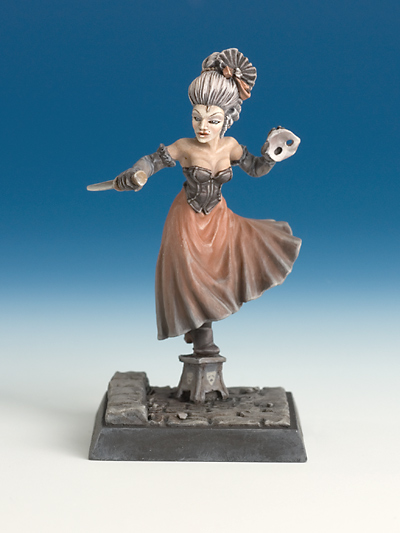
She's a fast-moving climber, somewhat fragile, but with access to ranged attacks and difficult to hit at range herself. She's also one of the few Brotherhood models who can take orders, which makes her even more useful as an accompaniment to the crew's leader.
The
Deckhands
of the Brotherhood are fairly basic.
Coscritti
are the raw recruits – untrained in the arts of stealth, still learning the duality of the mask. They're useful in melee, but are mostly there to help fill out your crew list and support them where necessary.
Harlequins
are a valuable asset to them – they are performers, moving around in broad daylight and accepted by the people, because no one suspects that a mask can have two meanings; the mark of a performer and the symbol of the Brotherhood. They're fast, have access to throwing knives, and are hard to hit at range.
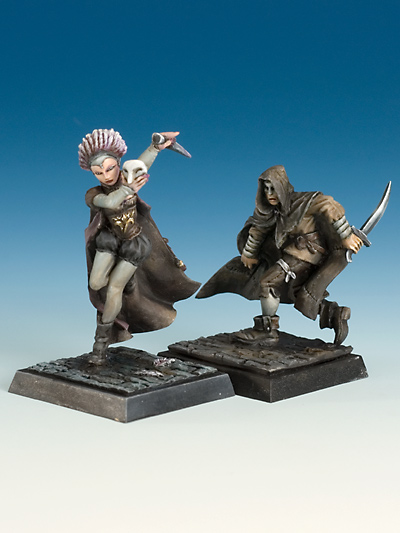
Deckhands! Harlequin is on the left, Coscritti is on the right.
The Brotherhood's crew construction is a little different than other crews – while they still have to hire a Leader and at least one Deckhand, they can hire two Specialists for every Deckhand they hire. Other than that, they follow the same rules for hiring Deckhands as the Pirates and the Goblin Pirates – you can hire more than one of the same type, but you need to hire a different type as well.
While the chapter is dripping in melodramatic prose, the text takes a bit of a tongue-in-cheek approach; while the Brotherhood is idealistic, it seems that no one really knows what they're idealistic about, and it's entirely possible that the entire story is a fake, invented to make people more willing to accept that they're in a shadowy organization of assassins.
Next time, we'll talk about
Mercenaries
, who can be hired by the various crews but aren't available as a crew themselves, along with some of the scenarios of
Freebooter's Fate
.
Mercenaries, Scenarios, and Closing Thoughts
Original SA post
Part 7: Mercenaries, Scenarios, and Closing Thoughts
Welcome back to this F&F of Freebooter's Fate , the pirate-y skirmish game that I just keep posting about. Last time, you heard about the overly flowery and idealistic Brotherhood, so now we'll cover the various mercenaries and the game's scenarios, as well as some closing thoughts.
Now, Mercenaries work a little differently from the rest of the models in Freebooter's Fate . With the publication of the first book, there was no possibility of fielding a mercenary-only crew. Instead, every mercenary is a Specialist that can be hired by another crew. Every crew can hire up to two mercenaries – except for the Brotherhood, who can only hire one – and they take up a Specialist slot when hired.
Lobo is a tough bastard. He's been a soldier of fortune for his entire life, and knows that it's not the romantic vision of gold and glory that the stories point it out to be. He's a natural cynic, which happens when a young orphan boy named Enrico requests that Lobo takes him under his wing. After failing to dissuade the young lad – and determining that any orphan who can survive the slums in Longfall is probably a tough customer – he has his new apprentice.
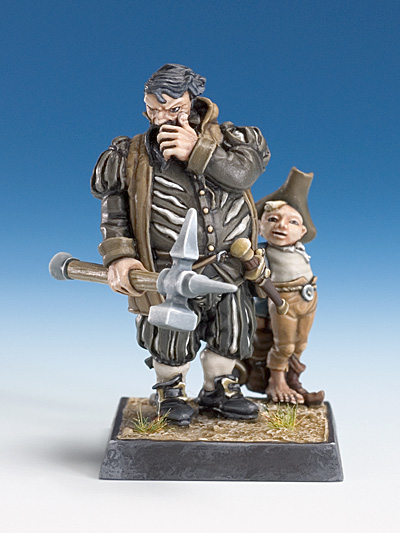
Lobo is a hard-hitting melee specialist, tough as nails and wielding a heavy warhammer. He's also got his loyal aide, Enrico, who will attack anyone who Lobo throws off balance with his flurry of blows. He's a good addition to any crew that needs a heavy hitter, although he will not fight for the Imperial Armada.
Brahyn is an angry, angry woman. A highland lass with an enormous sword, her introductory fiction shows that she's a fan of drinkin', fightin', and teachin' scunners not to mess with a lady's lunch, beating the hell out of several Brotherhood assassins who manage to inadvertently spill her lunch.
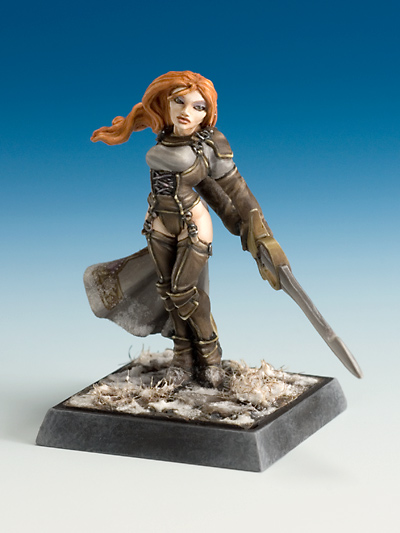
Okay, the pants are a little much.
She's another hard-hitting melee fighter, with no ranged capabilities but an incredibly huge two-handed sword with the highest strength in the game. She can also perform a flurry of blows in melee, getting an extra attack. She will not fight for the Brotherhood or the Goblin Pirates.
El Curandero is an overly-melodramatic poet who supports his work through mercenary work, specializing in acting as a battlefield surgeon. Beginning life as a blacksmith's apprentice, he thought the work unworthy of him and ran off to become a poet, writing about the ills of modern society. As he's not a particularly skilled poet – nor one who anyone bothers to notice – he finds himself drawn further and further into his work as a surgeon.
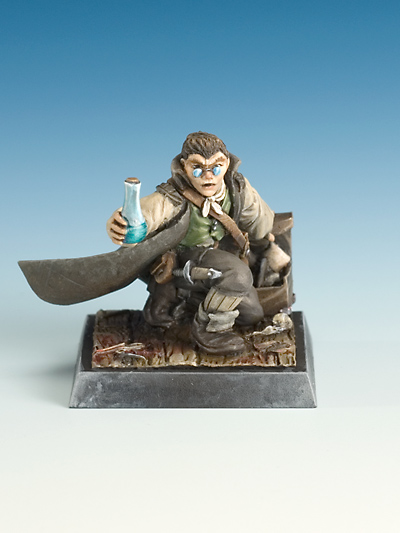
While rather weak in combat, he provides access to healing skills in battle. He won't fight for the Goblin Pirates, because he still has some self-respect.
Lindo Guapo is a man of mystery – he's supposedly the only man to ever leave the Brotherhood and live. No one knows if it's true – and Lindo certainly won't say anything – but the mask he wears at his belt, as well as the skills he practices, are enough to convince anyone that the rumors about him are true. If he did manage to leave the Brotherhood, no one knows how – and no one's willing to ask, either.
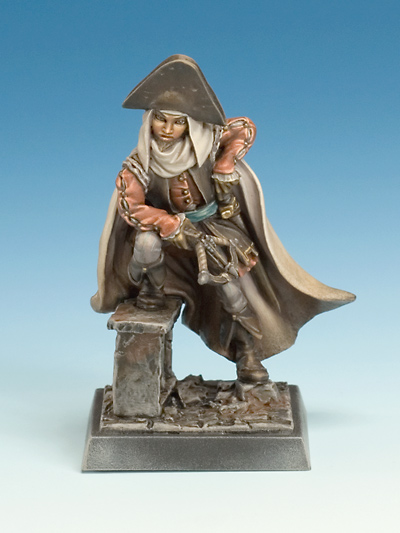
He's an excellent shot with his crossbow-pistol, and can handle himself in melee fairly well, but lacks the poison of the Brotherhood, so he's essentially a light version of their assassin specialists. He also moves very quickly, an advantage for the slower crews who need someone with decent range and good skill at range. He obviously won't fight for the Brotherhood.
Buscar is an iconoclast – he's fiercely independent, seeing himself as the master of his own fate. The only injustice is when someone tries to tell him what to do. He's a fan of private law, and tends to enforce it for anyone who's willing to pay him. Not much else to say, really.
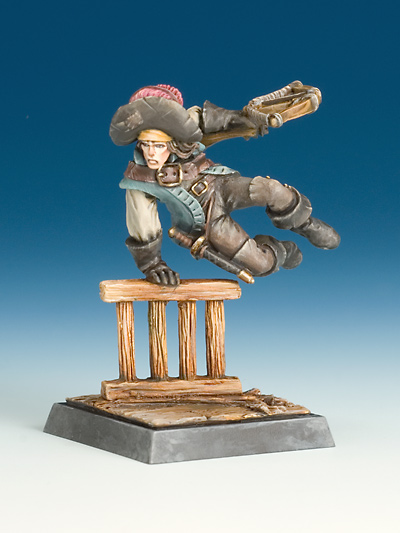
I kinda like the dynamic movement here.
He's a skilled crossbow user, with some capability in melee. His other standout feature is his ability to climb well. He won't fight for the Imperial Armada.
Now that you've heard about the various mercenaries, let's talk about the last chapter - scenarios. While simply having two crews fight each other can be fun, the real entertainment in this game is in scenarios, which are presented at the end of each book. There's also a few tips about setting up a table – including the suggestion that, for a truly immersive experience, you should open up a jar of pickled herring and place it under the table to simulate the smell of fishy brine that, by law, accompanies all pirate media.
Freebooter's Fate is a terrain-dense game; line-of-sight needs to be blocked to make sure that the board isn't just a series of firing lanes. Six to ten pieces are recommended, with players alternating the placement of terrain on the board. Certain crews even allow for an extra piece to be placed after the board is set up – only Brotherhood right now, but that'll be expanded later on.
The scenarios for the game are fairly simple to start with – later books add in mini-campaigns and suggestions for setting up linked scenarios in an attempt to create a narrative for the game, but there's not too much in the first book; mostly basic scenarios, but they're a big part of the flavor of the game. In general, you're looking to earn Glory Points , the game's term for victory points – usually, this is a combination of killing/panicking enemies and accomplishing scenario goals.
The Feud is your basic crew-fighting-crew scenario; justified in the typical Freebooter's Fate fashion by implying no one really knows why they're fighting. To quote the text;
Freebooter's Fate 96 posted:
Oh well, anyway, they're all drink-sodden bastards who deserve a good whacking. Also, they have gold and rum and we've got our Vanesa's engagement do coming up.
Right, let's get 'em!
The Treasure Hunt is a classic of the pirate genre – there's hidden treasure somewhere on the field, but someone else has stumbled on it at the same time. Even worse, whoever hid it had a sense of humor and a love of traps, so there's a few spare chests that have nothing other than incredibly painful traps in 'em. Victory is determined by getting the real treasure back to your deployment zone – as well as managing to survive the deadly traps.
For Rum and Glory , follows the traditional attacker-and-defender formula from most skirmish game. However, the goal isn't violence – it's delivering casks of rum. One side starts out with several barrels of rum, and the other side – hired by a group of teetotalers, no doubt – has to destroy the rum before it can be delivered to the tavern on the board. Glory points come from delivering the rum successfully, or – for the attacker – for destroying or stealing the casks of rum.
To Arms! is a clever little scenario – everyone starts out deployed in the center of the board, and the goal is to take out some of your opponent's miniatures while getting all of yours to a designated assembly point. Of particular note is the random nature of deployment; using face-down paper slips, all models are deployed randomly, so you don't know who is where when you start the game. It's a quite fun scenario, and one of the ones I use to demonstrate the game to newer players, as it shows the balance between achieving objectives and attacking your opponent.
The Hunt for Rats in October , shows the game's sense of humor with a series of puns regarding that classic piece of media. A number of rat tokens are placed on the board, and both sides need to find and catch the damn things to get the bounty from the city. It's chaotic and ridiculous – perfect for a game of pirates. There's typically a lot of scrambling to get rats, violent confrontation, and entertaining chaos.
The final scenario from the first book is Stranded , another classic bit of pirate media. Both crews start on opposite sides of a beach. In the center, there's the only boat off of this desolate island. The goal is to escape with your leader and as much of your crew as possible, while stopping your opponent from doing the same. The excellent rules for shoving people come into play here.
To sum things up, Freebooter's Fate is far from a perfect game, but it's one with a lot of charm and excellent balance. Relatively cheap to get into, and with some gorgeous miniatures, if you've got a chance to look into it, give it a shot. The rulebooks are fantastic – I can hardly tell they weren't written by a native English speaker, given how well the pirate theme shines through – with some very good art (that I haven't been showcasing because I don't have a working scanner.) Werner Klocke makes some beautiful minis, barring his tendency towards excessively cleavagey women.
Things that it does really well:
-
Ranged combat
: By requiring reloading, keeping ranged damage somewhat lower than melee, and making it so that it's easy to gain defensive bonuses against range, it does a great job of making ranged combat into a tactical component, rather than a dominant strategy.
-
Combat impact
: Combat feels less luck-based than most games I've played – the card system for attacking and defending is pretty unique, and while it can seem clunky while reading about it, it plays incredibly smoothly.
-
Pirate Feel
: It's steeped in genre conventions, the scenarios all emphasize the themes that the game is putting forward, and it feels like a properly pirate-y game, in the swashbuckler-films-of-bygone-eras style.
-
Movement
: This is a major part – the rules for navigating terrain are excellent. I've talked about them a bit here in general terms, but they're logically laid out, cover every edge case, and provide for every conceivable type of terrain you could encounter on the field. Hell, the
Use Item
action can even cover swinging on ropes and chandeliers, just to add to the experience! There are some nice innovations here.
Things it could do better:
-
Variety
: While the next few books address this, there's not a lot of playstyle changes for most of the crews – as you saw with the discussion of the Pirates, a lot of their models are fairly similar, and unlike some other skirmish games from the time, switching leaders doesn't really change how your crew plays; Pirates are generalists, Armada is shooty and tosses out orders, Goblins swarm, and Brotherhood sneaks around into melee. Most models have pretty similar stat ranges, as well – while this makes it easy to add stuff (I've written some scenarios with static cannons that can be fired, along with ship maneuvering), it also means that you're not going to be seeing crazy variations.
-
Swinginess of Combat
: One good hit can cripple a model. In extreme cases, you can see multiple models getting panicked or killed in one turn. It can help to emphasize cautious play, but it's turned some people off.
-
Limited model count
: There's not a lot of models out for it, and there's a fairly slow release schedule.
-
Sculpting Issues
: As this thread aptly showed, there's a lot of cheesecake in Klocke's sculpting. It improves over the next few releases – well, somewhat – but it's still there, and that can put people off.
Well, that's all for Freebooter's Fate . If anyone is interested, I could continue on and do the next book in the series, Deep Jungle , which introduces a new crew, the Amazons, as well as some new mechanics, an advancing storyline, and quite a few new scenarios. Thanks for reading, and I'm glad I was finally able to finish one of these properly.
Equipment
Original SA postJust to keep sharp (and because writing out everything for
Deep Jungle
is a bit of a pain), might as well explain another facet of
Freebooter's Fate
with a discussion of a mini-expansion of sorts - equipment cards.

Freebooter's Fate: Equipment
Because this game loves the use of cards to help manage special elements and all of that, a mini-expansion, released after
Deep Jungle
, was designed to help provide more options and customization to crews. This greatly helps one of the earlier criticisms of the game; while there's a slow release schedule, equipment cards help to provide variation for crews and give more customization for players. Released in dual-language German/English, the cards provide additional equipment that modify the characteristics and traits for your crew. (I know, it sounds like ad copy, but it's the best explanation I've got for it.)
The basic rules for extra equipment are simple; no more than three pieces on a character, no more than one large/Rare item per character, and only one copy of each Rare item per crew. Additionally, some items require that a character has certain equipment to use it - a Pre-Fragmented bullet, for example, is only useful to someone who already has a blackpowder weapon. They generally grant traits, add to characteristics, or allow for some truly miraculous events to occur.
There are a few notable bits of equipment to mention here.
-
A Jar of Mud
: Referencing
Pirates of the Caribbean: Whatever The Second One That I Can't Be Arsed To Look Up Was Called
, it's a jar of mud. No one else has something like this.
-
Fistful of Sand
: Pocket sand!
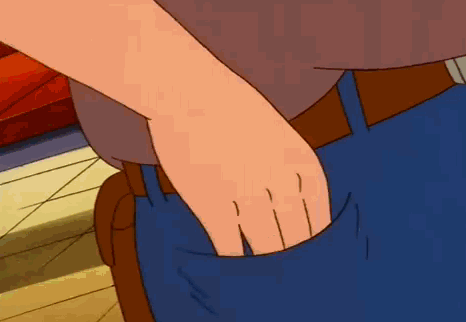 Temporarily blind an opponent. Only poseurs use anything other than the stuff you find on the ground.
Temporarily blind an opponent. Only poseurs use anything other than the stuff you find on the ground.
-
Snuffbox
: In classic military lore, this adds to the character's toughness for the first hit to the torso they take.
-
Bottle of Rum
: Provides some additional "motivation" (Morale) to the character holding it.
Part of the reason I'm discussing this is because it shows one of the strengths of the system - in true German format, all of the dubloon values for traits and characteristics are tied into a sort of formula, which you can catch glimpses of when examining the equipment cards and comparing various models. There are "standard human/goblin" values for most traits, with some variation given for training and other elements, which can be determined through careful comparison of cards. It's a neat glimpse into the design process behind the models, as well as methods of further customizing the game beyond the basic listed stats.
There's also another element to this; because of the slow pace of releases, a lot of additional information and abilities exist that aren't mentioned in any of the released books. There's a lot of neat supplementary stuff out there that hasn't been collected into books yet; for example, the East Leoneran Trading Company box set, or Mercenary Starter, only has its rules available in the box set. While this can be a little frustrating for those of us who like to know rules from books, there's an advantage to it - they can continuously release models in between book releases, similar to how Warmahordes manages their release schedule. It's a good way to keep up the release pace, especially if miniatures are designed before the rules are. Seeing as Freebooter Miniatures started as a company that only sculpted miniatures, it makes complete sense - they're more interested in the artistic aspect for a lot of these minis, and the rules can come second. It also reinforces the nature of the game as one that's meant to be somewhat casual - while it's quite well-balanced, they're not looking to run major tournaments or do anything more than have people enjoy playing with some minis.
So, next time, I'll cover Deep Jungle , which introduces the Amazon crew and tightens the already-impressive rules regarding terrain.
EDIT: Found some of the concept art used in the sculpting of the minis. Apparently, Lydia Schuchmann, who's done work for Pathfinder , among other things, did the concept art for my favorite mini, Mieido a Morir.
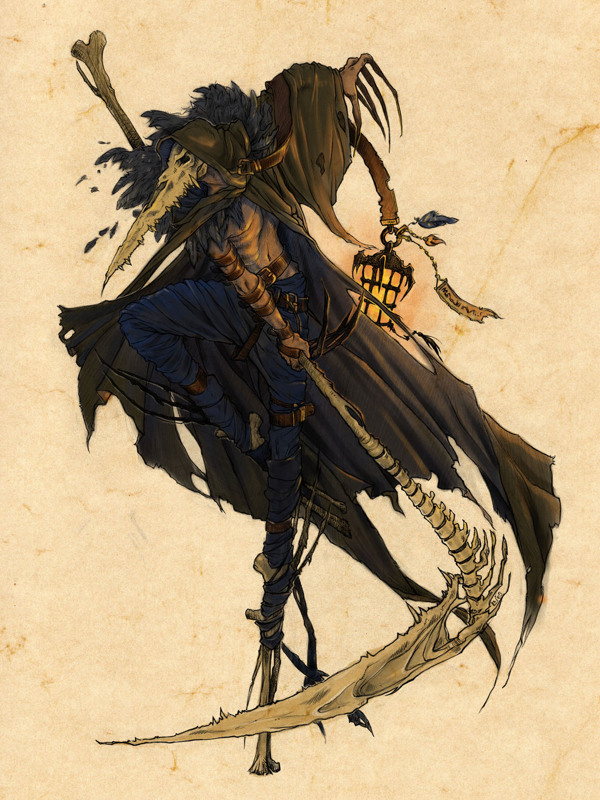
Deep Jungle
Original SA post
All right, welcome back to this F&F of Freebooter's Fate , the German pirate skirmish game that is pretty damn cool. This time, we're going to be learning about Deep Jungle , the first major expansion to Freebooter's Fate.
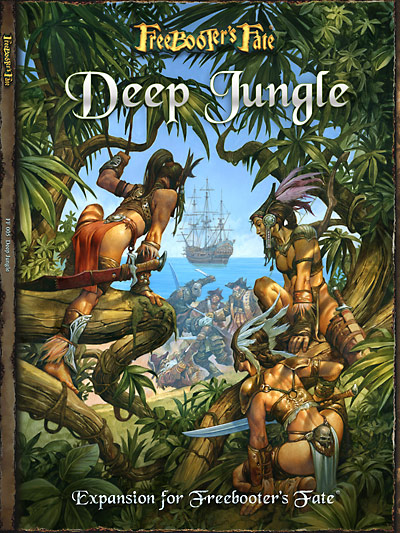
Starting off with a great (and, according to the credits mysterious) cover illustration, drawn by Gabor Szikszai and the amazingly-named Zoltan Boros, the book proper begins with a general recounting of the game's progress in Germany. Coming 18 months after the first game, the idea for this book came from a desire to add more variation to the crews and polish up an idea they'd had since the beginning: Amazons. With all the discussion here regarding some of the design choices, I only feel it appropriate to mention that the introduction mentions that, ”female characters are one of our specialties.” I mean, at least they're trying . . . ?
Introductory Fiction: Longfall
We rejoin our hapless tourist Javier from the introductory fiction of the first book as he contemplates his choices in life. Rather than joining a pirate crew – with Blanche Pascal's hinted as being at the forefront – Javier settled into the simple life of a dockworker, inexorably drawn to the city of Longfall, which at this point is well and truly in control of the pirates.
Javier hears a familiar shout, and we get our next taste of Freebooter slang – fighting is so common in the streets that the various skirmishes are simply called ”Tiffies” now. Confronted with a frenzied pirate, Javier is nearly toast, but ends up saved by an unlikely friend – the pirate Krud, who has been a fast friend after both of them got tossed out of a pub for running out of coin, fought off a mugging, and got even drunker on the contents of the now-departed thief's funds.
The situation in Longfall is growing a bit more tense – the alliance of pirates that wrest the city from the Empire has disintegrated, leading to a great deal of infighting. The ringleader is the pirate Asqueroso, whose name is mentioned with some degree of trepidation – even other pirates think they're bad. Javier, having relieved his attacker of his purse, heads off to work.
Meanwhile, news arrives at the Gobernador's office. Things are not good on Leonera for them, but it's even worse in the colonies on Elsura – the goblins have officially taken control of them, much to the chagrin of those officials who saw it as a easy source of embezzled wealth. Captain Garcia, already annoyed at the brazen antics of the criminal scum in Longfall, considers the whole situation tiresome, the jingoistic plans of the Gobernador short-sighted, and a recent message requiring some of the garrison a trap to finally lose them any hope of regaining Puerto Alto.
Returning to Javier, he's busy cleaning his newly-purchased pub – taken from the rather impressive purse he claimed from the pirate from earlier – and he ends up stumbling on a meeting of the important pirate captains. We're familiar with two of them already – Blanche Paschal, the pirate queen, and Captain Rosso, the daring paychest thief – but the next two are new; Asqueroso, who fancies himself the brilliant architect of Longfall, and Regicide Alvarez, whose temper is legendary. Asqueroso has big plans – completely kicking the Empire out of Longfall before driving out the rest of the scum who are keeping it from being a pirate's paradise. Asqueroso explains – in the most condescending and grandiose manner possible, setting him up as a complete pillock – that he's lured the remaining Imperial garrison out of Longfall, and the remaining soldiers could easily be driven out of the fortress. When the captains agree with Asqueroso's plans, Javier sighs – it's likely he'll die if things get any worse.
Two weeks later, the pirates are celebrating – the plan was successful, the Empire has been kicked out, and Longfall is theirs. The alliance, however, is already disintegrating – Asqueroso is looking to set himself as the sole leader of Longfall. The Imperial garrison has retreated to one of their forts in the jungle, much to the chagrin of the occupying pirates, and it looks like they'll hold out there for a while.
Captain Garcia's expedition, having confirmed that the message was a forgery, is planning on returning immediately to Longfall, convinced that something is amiss. Figuring out the plan of the pirates, he plans to circle around, meet up with Captain Leon, take the long route through the jungles of Leonera, and bypass the coastal defenses. A few lucky guesses leads him to a nearby shipwreck, consisting of Imperial sailors retreating from a pirate ambush and a nasty storm – the source of the original letter. They've got word from the mainland – the Empire is at full-scale war with Maland, and that means that resources are going to be scarce.
It's not too long before word reaches the pirates in Longfall regarding their plans, but it sounds like they've still got some time to work on their defenses. Tensions are running high among the various crews as the pirate alliance, already fragile, starts to disintegrate in the form of bar fights.
Things are temporarily eased when Long John, the legendary pirate liar, swaggers into Javier's bar and begins telling a fanciful tale of the Febbos, mysterious tattooed women who have been coming out of the jungle, ambushing various patrols and suddenly showing a great deal of irritation at the presence of outsiders. Others confirm the rumors, while someone manages to disentangle Long John's unique word puzzles - ”Fe” for the feathers they wear, and ”bo” for the first thing a pirate would notice.
There's rumors of things stirring in the jungle – whether it's the constant cannon fire, the sudden advances of the Imperials into the jungle, or something else, Leonera is becoming a more interesting place – not comforting news for Javier, who was hoping for an easier life than the one that's been thrust upon him.
New Rules and Updates
Seeing as this is a shorter section than in the first book, I'll just cover the new additions here.
First off, terrain is clarified – it's now divided into terrain classes , which all have universal rules to make things easier. Given the emphasis on movement and maneuvering in this game, it's a welcome change – it's here to tighten the already-clear rules for terrain. Terrain can also have traits , similar to characters, which makes it easier to design and describe the board. There's a lot of options here – nothing too complicated, and the rules recommend ”If it looks like it fits the piece, then that's what it does” - you can even mark pieces with a little bit of ”pirate-sign” to indicate what traits and classes it has.
The terrain rules are also expanded to include the effects of higher ground on combat – there's a distinct advantage to having the high position. There's also a few new general actions for models – the ability to pull models down from higher terrain, as well as shoulder-charging models off of high places. It's a great way to emphasize how important positioning is – as well as how many ways you can mess with your opponent's positioning.
As usual, there are some new traits and special actions – we've now got rules for trained animals, which act like models that can receive orders, but need to be in their controller's authority radius. They're a little dumber than most models – if their controller isn't paying attention, then they risk going out of control and acting randomly. The new traits are the usual expansions – mostly condensing previous abilities down into keywords that are indexed in the book.
The most interesting trait, and one that bears examination, is Honour Guard . If a model with that is leading the crew, then deckhands of the type indicated can be designated as part of the honour guard – they are strengthened somehow (usually gaining a new Trait), cost slightly more to hire, and ignore the usual restrictions for hiring deckhands; no need to alternate types when you've got an Honour Guard. It helps make themed crews a lot easier, especially considering the number of Leaders with the trait made available in this book.
Next time, we'll talk about the newest crew in Freebooter's Fate – the Amazons.
The Amazon Crew
Original SA post
Part II: The Amazon Crew
So, welcome back to this F&F of Freebooter's Fate – this time, I'll be talking about the Amazons, the newest crew to be added to the game. Be prepared for some eye-rolling when regarding the miniatures – while I can confirm that some of the concept art and designs really were designed by women, it still doesn't make it any less grognardy in design. Still, they've got some neat designs here and there, so it's a mixed bag.
As far as playstyle, Amazons are quite similar to the Brotherhood, in that they emphasize movement, positioning, and striking where they'll be most effective. Unlike the Brotherhood, however, they're capable of cooperation, have a ton of hit-and-run maneuvers (including access to incredibly rare ”Take a double-move and pause anywhere to shoot someone” action), and rely a lot less on specialists to do their dirty work – their Deckhands are one of their best options. Many of their models tend to have a lot of health, but not a ton of resistance to damage, so your best bet is to make use of terrain for quick, surgical strikes. They get a lot of poison, pretty much all have access to ranged weapons, and are a tactically-rewarding ”glass cannon” style of force.
The short fiction that starts off the new Amazon crew is one part characterization, one part infodump regarding the background and reasoning behind why a bunch of Amazons are suddenly showing up in the game. It's a meeting of the Great Council of the Amazons, where the five senior priestesses of the five largest tribes are meeting with the High Priestess – it's a big deal, because this sort of thing only happens when something is going seriously wrong.
We get a bit of history and background for the Amazons – they revere the Earth Mother, a fancy name for the flowing harmony of life in the world, and they originally settled on some ruins of long-dead society, which contained many prophecies and details of how to live in harmony with the world. Each tribe sends guardians to the temple, to attend to its maintenance, serve the High Queen and the High Priestess, and see that things keep going well for the Amazons.
Unfortunately, all is not well. Something is choking off the life force of the world – the harvests have been poor, many hunters have been killed, and life is just generally going badly. Something has happened to one of the Amayalli – sites dedicated to the Earth Mother that channel her power. It's been choked off somewhere to the West, and that means that all of the tribes need to work together to see that their way of life doesn't die off.
There are a few tribes mentioned here: the Ocelot tribe, which is rather more modern and forward-thinking in how they take in any women seeking refuge and train them (as well as getting quite a few honors from the Great Council), the Epatl tribe, which is mostly formed of traditionalists, and the Canahuatli tribe, coastal-dwellers who are skilled fisherwomen and raiders. They also make mention of the Oquichtli, who live near the Amazons and supply them with the occasional man on their raids, along with a great number of women who wish to leave the patriarchial society and join up where they'll be respected.
With the council concluded, the Axe of Wrath is raised – it's time for the Amazons to go to war, reclaim their sacred sites, and kill anyone who has managed to anger the Earth Mother.
It's a pretty basic introduction, but does a good job showing how the Amazons function – they're not some idealistic society, but tribal hunters and farmers who have their own political rivalries and work. Far from the usual ”primitives” that the genre loves, they know about technology – they just think it's useless and out of harmony with the world. There's also not nearly as much man-hating as you'd expect from the genre – the tribes are split on how to handle them. Most tribes are fine with ignoring other societies so long as they're left alone. Others take in the occasional old male, recognizing knowledge and pointing out how they're the ones with all the power over the occasional shipwrecked sailor who lands on their coasts. Finally, others are all about seeing men subjugated – still, it's a nice mix of ideas and prevents them from being too much of a one-note society.
Now that we've got that out of the way, let's talk about Leaders for the Amazons.
Pehua is one of the two leaders of the Ocelot tribe chosen to lead the expedition of the Amazons into Leonera. Despite her honour at being chosen for this role, she's quite skeptical as to the reasoning behind it – she was not born to an Amazon tribe, but joined when she and her sister were found in the jungle. Despite wholehearted belief in the rightness of her cause and the strength of the prophecies, she's wondering if this whole mission is a trick – is it one of the other tribes playing a political game, weakening Ocelot so that their lands could be claimed? Is it really necessary to do this? It could have just been a string of bad harvests, and this sort of campaign is going to lead to a lot of her sisters dying. Hell, even worse, they might not even succeed – what would be worse than going back disgraced? All these thoughts are pushed to the side when the group of pirates she's tracking duck into sight – she is a hunter, completely focused on her prey, and the ambush goes off successfully.
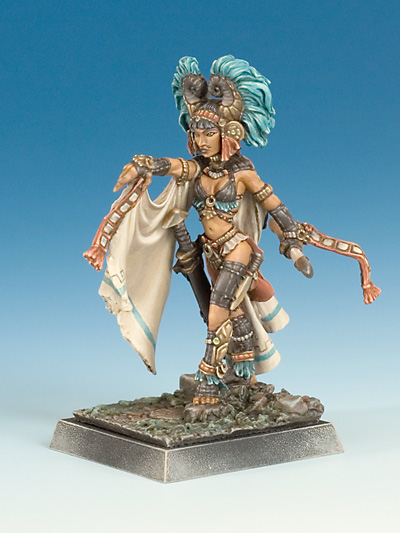
Giant headdresses are going to be a theme here. Also, note how the skin tone isn't just ”white person” - good job, painter!
As a leader, Pehua is here for incredibly mobility in jungle terrain. She's got a bow that hits like a heavy rifle, is difficult to hit (or even find) in jungle terrain, and has the aforementioned Assault Shot action available. She also has access to the Honour Guard rules – she upgrades the Matqueh deckhands, which I'll discuss later with the Deckhands. Despite her ranged focus, she's got decent staying power in melee, as well – mostly geared towards hit-and-run tactics, but still good.
And, because for no reason other than making me cringe, they mention that she's taken a vow of silence until all the men of the world are subjugated, refusing to speak any words until that's been accomplished. It has no in-game effect – she can still give orders, but they're in the form of hand gestures and bird noises, and serves no real purpose for the game. It was so close . . .
Yolcameh is the other leader available for the Amazons, as well as Pehua's birth sister and fellow member of the Ocelot tribe. Both of them joined the Amazons with their mother, who was fleeing an abusive husband, and of the two sisters, she's a little bit less serious in her outlook. We join her as she is the first Amazon to set foot on Leonera – in part because she's an eager, irresponsible warrior, and in part because she absolutely hates boats. She's seen as a reckless, indominable warrior – an inspiring figure for the Amazons accompanying her, and has survived more than anyone has the right to. Taking the time to shout out a speech to her warriors, she scares off the game in the jungle, likely annoying her sister, but that's the way she likes to go about things.
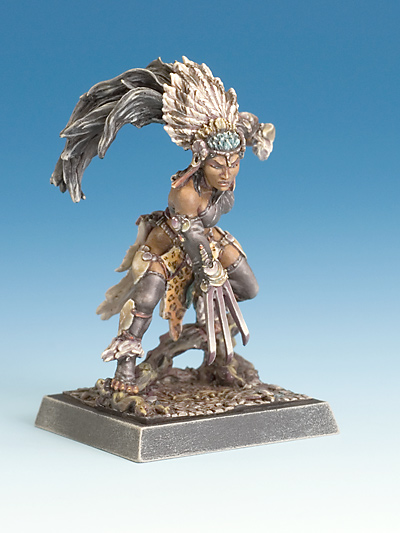
Basically the Amazon equivalent of Wolverine.
Yolcameh is a melee monster – a little slow (for an Amazon, mind), but with excellent mobility in dense terrain, good ability to draw on cover mechanics, and some really dangerous abilities in a melee. She's also the first model with a new trait that comes up a few times – Indestructible – which gives her a 50% chance of surviving an attack that would kill her and staying in the game. Like Pehua, she can upgrade her deckhands with Honour Guard – in this case, it's the Chicomeh who get the upgrade. Tilting the focus towards heavy-hitting melee, she covers the other angle of the Amazons.
Now that you've seen the leaders, let's talk about Amazon Specialists . They're closest to the Pirates in how their specialists are laid out – they tend to have a mix of abilities that fit in theme with the general playstyle, but most have access to melee and ranged combat, hitting hard and moving fast.
Tocatl is a great hunter for the Amazons – she was skilled in bringing down tricky prey, and her prowess at stalking dangerous game has let her contribute to the Amazon's mission very well – she's the terror of forest patrols, striking out of nowhere with her twin daggers. Her totem animal is the spider, and she has a weird tendency to eat them when they drop onto her knives. In the fiction introducing her, she ambushes a patrol of Imperial soldiers, killing their sergeant and escaping before anyone can see her, leaving them terrified. Well, almost everyone – remember the creepy spider-masked Brotherhood specialist, Fith'Arach? Well, he notices and becomes just a little bit more creepy by developing a crush on the creepy spider-Amazon.
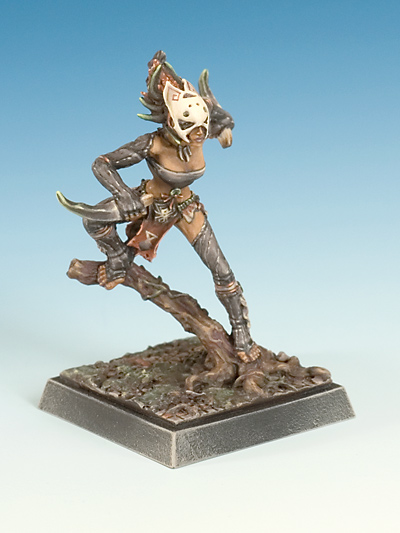
Rocking a cooler mask than a lot of the Brotherhood.
She's got excellent mobility, access to poison, and is hard to detect in jungle environments. Thanks to using two weapons, it's hard for criticals to take out her attacking strength, and while she lacks ranged combat skills and isn't the hardest-hitting Amazon, her mobility and terrain abilities make her a damn good choice for melee backup in a fast moving crew.
Occepa is another Amazon adopted into one of the tribes. When she was young, most of the tribe members thought she wasn't cut out for the life, as she never seemed to get the hang of the necessary skills for surviving in the jungle. While she was playing by the river with a doll she retained from her time with the clothskins (the Amazon term for outsiders), she gets attacked by a large crocodile, which steals her doll. Furious at this, she grabs a nearby branch and whacks it, giving the warrior watching over the area time to kill the thing. After getting a tooth from it, she found her totem, and has killed quite a few of the things, fashioning armor from their bones and hide.
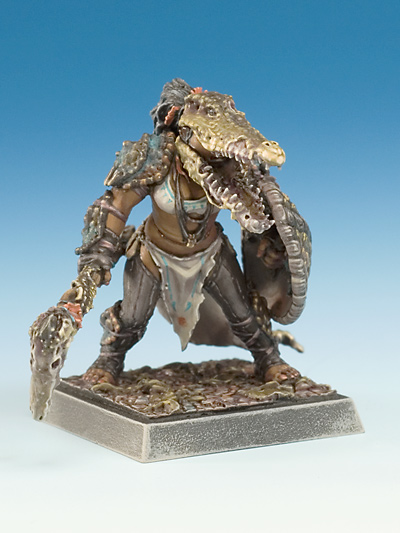
I think that the concept is pretty badass, even if it's a nightmare to paint.
She's a melee beatstick – slower than most Amazons, she's got a ton of vitality and toughness, compounded by a shield and a heavy club. While she's not exactly stealthy, she's damn good at hitting things and making sure that they stay down.
Totol is a hunter – skilled, but slightly overconfident in her abilities. Her story introduces another aspect of Amazon culture in the form of a blood-feud between her and another hunter, Cihuachi. The ritual combat portion is fairly interesting – best of three strikes, wearing conch-shells on the hands to both make visible cuts and reduce the chance of a deadly strike, in the center of a ring of hot coals. We learn a bit about the Amazon concept of honour – they recognize that people are going to fight, so better that it's done in a ritualized, public fashion so that everyone can see the result, rather than endangering others while in a fight. Despite taking the first hit, Totol is confident she can win, and the story ends as she rushes in again.
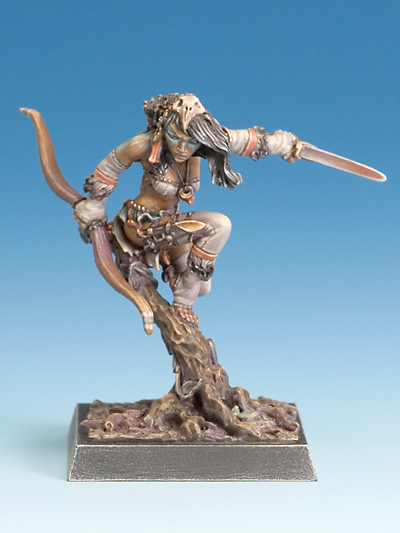
She's the classic hunter – almost identical in abilities to Pehua, which makes sense given her role as a hunter. She lacks access to Assault Shot, but she's got a heavy bow and slightly better melee capabilities, as well as the ability to spend an action to poison any of her weapons.
Macati is a warrior from the Campamocha tribe, and her story starts with her undergoing the traditional ritual for determining the greatest warrior in the tribe – hunting down a deadly giant mantis. She's nervous, but she's looking forward to stalking and killing the ultimate predator – there are some little references to the film Predator , which again shows that this isn't a completely serious game. After stalking the thing for hours, she is nearly killed when it suddenly springs out of hiding. After shattering her obsidian spear in its claws, she decides on an all-or-nothing charge, leaping foward and killing it with her back-up knife. Successful, she hauls the corpse home, having successfully become her tribe's mantis warrior.
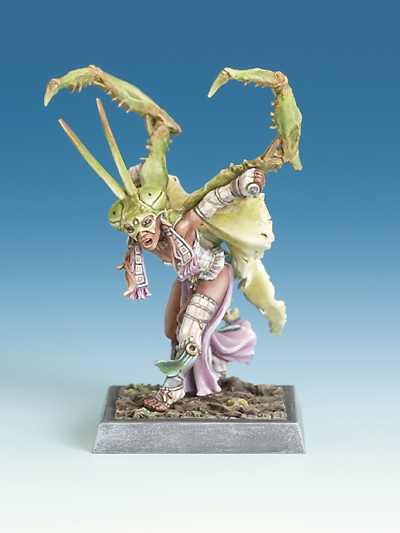
While totally impractical in the real world, you have to admit you'd wear a giant mantis exoskeleton if you could.
As far as abilities, she's got a combination weapon/armor in the form of hardened mantis chitin plates and a pair of giant mantis arms, controlled via pulleys and rope. She's fairly tough, but the arms are the main part – she's got two, so she's not crippled if she takes a critical to one, and enemies are prone to fleeing when they're in melee with her. She's got no ranged combat capability, but she's also got mantis claws, so I think that makes up for it.
Tecuani is a bit of an odd duck amongst the Amazons. When she stumbled on a few onca cubs orphaned by a posse of apes, she felt sorry for them and decided to take them in and feed them. This provides a glimpse into her background – before she joined the Amazons, she'd been chased out of her village for her skill at dealing with animals. Well, the actual event that led to her being chased out was attempting to introduce the fainting goat into her village's herds – they'd declared it unnatural in the form of an angry mob, and so she joined the Amazons. Taking the cubs back to her village, she was given permission to try and train them, and she's been quite successful, even if her earlier experiments led to the nicknames, ”scarleg”, ”scar face”, and ”scar everything” - cats are jerks, you see. She's developed her techniques, and together with the great-grandchildren of the original cubs, she's planning on showing how dangerous the jungles can be.
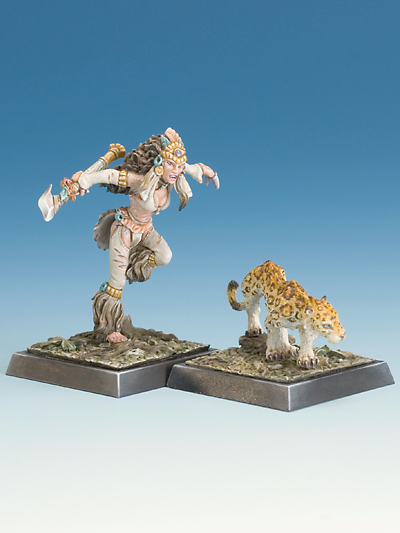
Notably absent – the scars. Still, decent mini.
She's got access to the new trait Animal Handler, and can hire several oncas for the Amazon crew. As animals, they're incredibly fast, pass through terrain easily, and can do some serious damage if they get into melee. If you're not hiring Oncas, she's not worth hiring, but then again, she gives access to cheap murder-cats, so she can lead to a huge model advantage, especiall considering how cheap they are to hire together.
The Deckhands of the Amazons are pretty basic. Chicomeh are the warriors of the tribes – in their introductory fiction, they've found a high-born lady who spends a lot of time insulting them after they start laughing at the pointless crap she's lugging through the jungle. They can have their morale upgraded if taken as Yocamleh's honour guard. They've got two knives, fast movement, and good ability to move through terrain. Matqueh are the hunters – in their intro fiction, they show that they're well-aware of how dumb pirates are, especially men around the lightly-clad Amazons, and use that to take out a much larger force. They get blowguns, the ability to use poison, and, if taken as Pehua's honour guard, access to Assault Shot. Damn dangerous deckhands, to say the least.
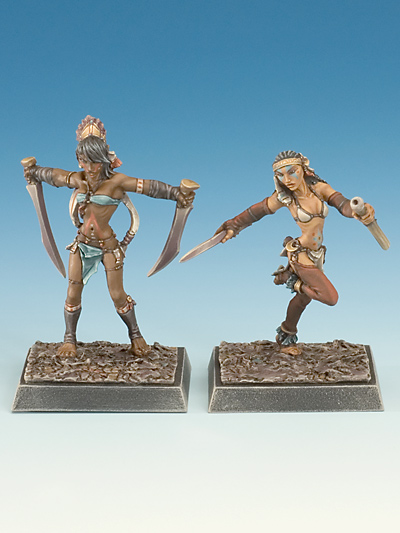
Equipment should tip you off, but just in case – Chicomeh on the left, Matqueh on the right.
As far as hiring rules, the Amazons are pretty much identical to standard crews – 1 leader, at least 1 deckhand, and 1 specialist per deckhand. They can choose to hire up to one mercenary, but cannot ever hire male mercenaries – they have their pride, after all. They also get the ability to replace a piece of terrain with a similarly-sized piece of Jungle terrain – they'd never be dumb enough to fight without the advantage there.
Next time, I'll be covering the new units available to the Pirates and the Imperial Armada , including the greatest piece of concept art I've ever seen.
Pirates and Imperial Armada
Original SA post
Part III: Pirates and Imperial Armada.
Welcome back to this F&F of Freebooter's Fate: Deep Jungle . Today, I'll be talking about the new crew options for the Pirates and the Imperial Armada – there's a lot less here now than there was in the initial book, so I'm going to try and cover two Crews per post now. So, let's see where the storyline has gone.
The Pirates have had a banner year – they've successfully taken over Longfall, kicked out the Empire, and have been living well off of their new city. Unfortunately, tensions are running high as the individual Captains attempt to set themselves atop the new status quo. There's also the trouble of all the Amazons showing up and keeping them from hitting the Empire in their jungle fallback point, so things aren't perfect for the crews. So, with all that said, let's talk about the new Leaders the Pirates have available.
Regicide Alvarez is introduced aboard her ship, the Sierpe alongside her crew. She's just purchased a new gun, and when some seawater gets into the mechanisms, she decides to fix it herself. When a new crew member asks why everyone is suddenly nervous, he's enlightened as to Regicide's rather heated temper – various stories of the mechanical devices that have succumb to her wrath are legendary among the crew, and anyone dumb enough to try and get her to calm down is pretty much suicidal. The list of things that piss her off is quite extensive – including people mispronouncing her name, which has led to quite a few barroom deaths. The best option is to find something to fight, point her in the right direction, and pray that the loot is good enough to improve her temper.
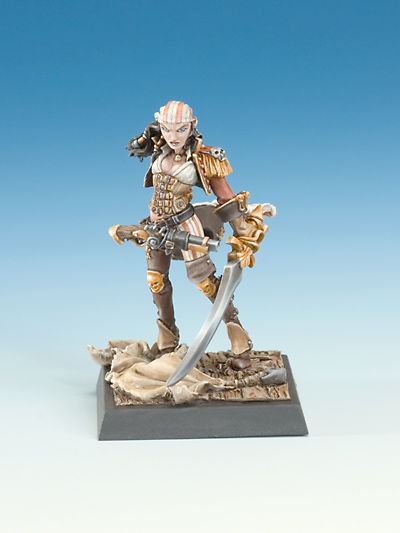
Pictured – anger.
As far as leaders, she's the standard Pirate – good toughness, skilled in melee and at range, and capable of handing out orders. Until she gets injured, that is – when that happens, she gets to recheck morale if she fails a test, gains strength and toughness, and is generally a horrifying monster in melee. She's pretty middle-of-the-road, although having a plan to get her closer to the enemy before she takes an injury is a good tactical idea.
Barco Malcaduco is the other leader available to the Pirates. If Regicide scares people with her anger, Barco scares people because he's a half-dead wreck of a man who was so notorious his crew was scared to finish him off when he was set on fire, lost an arm and an eye, and was crushed under a heavy rock, instead choosing to maroon him on an island. Rather than waiting for death, he chose revenge, and hunted down the mutineers before reclaiming his ship, his crew, and his hat.
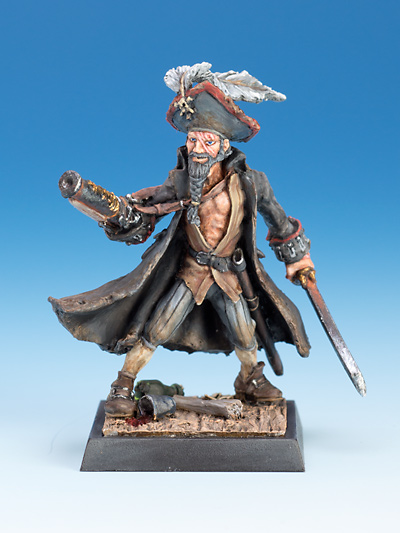
Not a fan of the sculpt or the official paint-job, but a pretty cool concept.
Barco has replaced his missing hand with a giant pistol – closer to a rifle in stats, mind – and is terrifying in melee and at range. Due to his injuries, anyone getting into melee with him has to resist the urge to flee from the apparently half-dead spirit of vengeance bearing down on him, but as a disadvantage, he loses access to the Aim action, thanks to his missing eye. He's also so well-known among the scum of Longfall that any crew can hire an extra specialist or mercenary beyond what they'd normally be allowed.
Now, let's talk Specialists . The pirates get two this time around.
Ex-Captain Jack is a living symbol of why Pirates shouldn't get old. Half-blind, missing both legs, and carrying a mummified parrot on his shoulder, he's only got a tenuous grasp on reality, the things happening around him, and frequently believes that he's dealing with people who have been dead for a long time or may never have existed in the first place. His introductory fiction shows him barreling through a wall, angrily confronting the hapless dockworker he believes to be at least three different people over the course of the conversation, and then wandering off again, leaving only a shattered wall and a dockworker swearing that, no matter how much rum it took, he'd drink enough to forget this had ever happened.
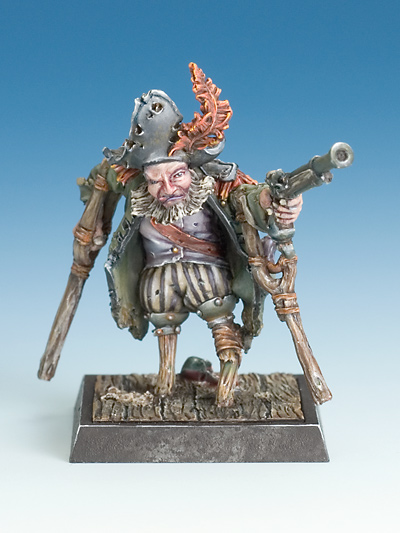
I love this crazy bastard.
Ex-Captain Jack can barely move – relying on random distance every time he wants to move, can randomly be controlled by your opponent, and may suddenly gain the ability to actually be effective in combat. He's got a heavy pistol, which he's not particularly good with, but at the same time, he's cheaper than most Deckhands to hire, so he can be a decent choice to fill out a crew if you're desperate.
Casimeere Flynn is the perfect image of a gentleman pirate. Always impeccably dressed, freshly groomed, and courteous to a fault, he's like something out of a terrible romance novel, especially given his tendency for theatrics. He's managed some ridiculous feats – stories tell of him managing to take a whole passel of noblemen's wives hostage with just some charm, and he's avoided pissing off the numerous male pirates who would normally eat a prissy boy like Flynn for lunch. In the fiction introducing him, he's joining the crew of Blanche Pascal, who notes the favorable effect he has on her crew and even considers taking advantage of him. It's the classic ”Roguish pirate” from the golden days of Hollywood brought to the table.
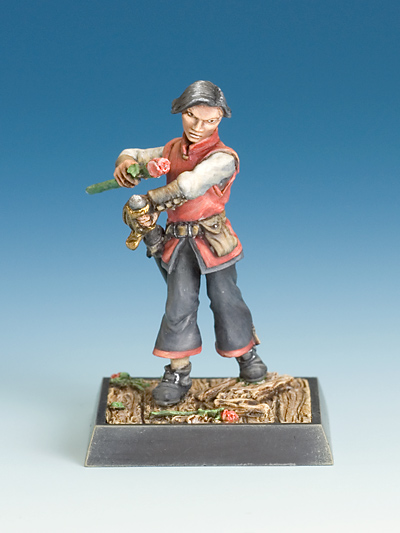
This is a terrible sculpt. I'm not really a fan of the concept art either, but it's just so stiff and awkward-looking.
While he's a bit expensive for his abilities, he's got the standard pirate loadout of a sword and a pistol, along with some average abilities. Notably, however, is his ability to Parry – remember the combat resolution mechanic? Well, if your opponent manages to get a hit, Parry allows you to force them to randomly replace the hit with an unused location card, making it a lot easier to keep him alive in melee.
That's it for the Pirates, so let's talk about the Imperial Armada . They're in dire straits these days – they've been forced into the jungles, and their best Captains are still trying to rejoin the main forces. Fortunately, there's some help from the mainland, as some new equipment loadouts and troops have been sent to retake Longfall, but it may be a case of too little, too late – the wars on the mainland are occupying most of their time. With that said, let's see the new Leader for the Armada.
Jarrõno is what Pratchett would refer to as ”God's gift to the enemy”. He's the Gobernador's nephew, a righteous fop who was sent to Leonera for a chance to get his first taste of command. He's not exactly this generation's finest tactical mind – being one of the many signs that the Empire's insistence that officers come from the finest of noble stock, the sum total of his military education is distilled thusly:
Deep Jungle 42 posted:
“So, what did you learn at the Academy?” the Gobernador asked, desperate to find some shred of evidence that the decision he was being forced to make could be justified.
“Oh,” said Jarrõno, eyes alight at the mention of a topic which obviously was dear to his heart, “a lot of useful things, actually. Where to find the best drinking establishments, which boutiques carried the latest fashions, how to dress like a proper gentleman, how to deal with servants, how best to recover from a radishing when you’ve lost a bet. And, of course, how to get lucky with the ladies. Fnar fnar . . . Oh, there were some stuffy men talking about militar whatnots and pushing little men around in sandboxes and stuff. One did not pay any attention to them, that kind of thing was strictly for oiks and peasants.”
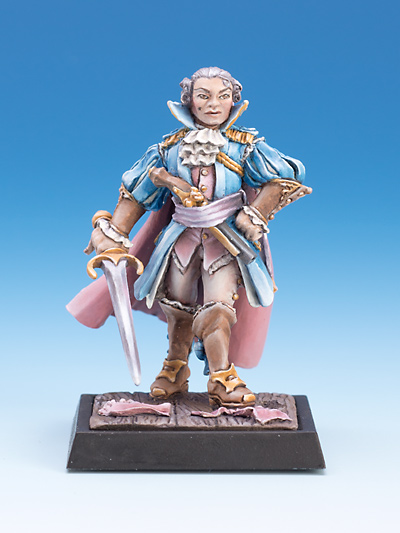
For stats, Jarrõno is a first amongst leaders – he's got no authority whatsoever. If he's part of a crew, you'll need lieutenants or sergeants to handle the actual giving of orders and inspiring of the troops – he's just too important for all that stuff. He's got a parrying sword, a dueling pistol, and the ability to bestow his personal favor on one of your troops in the form of a well-made weapon. Because of his familial connections, he can also afford to outfit an Honour Guard – Marines gain the Parry ability for an increased hire fee. He's basically a joke leader, but makes room for hiring specialists and deckhands.
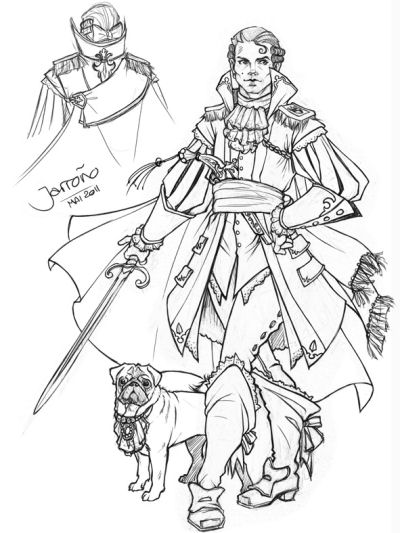
I fucking love his concept art – seriously, look at that pug!
I'm also including his concept art, because it's amazing and it's a goddamn crime that the pug wasn't included on his official miniature. If he came with the pug, I'd be running Imperial Armada under Jarrõno all the time.
The new Imperial Specialists are Ahondaros , who apparently come from the game's version of Australia, spending most of their time smoking, cooking meat, drinking beer, and digging incredibly complicated fortifications with criminally unsafe amounts of gunpowder. Thanks to their skill at turning bits of the jungle into rather less jungle and the quick building of fortifications, they're a little outside the usual field of discipline, to say the least.
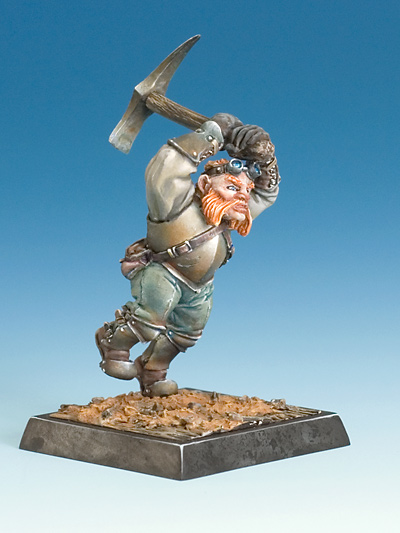
While they're not exactly super-useful in a fight, having only their pickaxe to work with, they let you destroy one item of scenery after everything's been placed, replacing it with a pile of rubble. They can't destroy anything that's scenario-specific and, as a further clarification, refuse to destroy anything that might be a pub. They can also place terrain on the field, erecting barricades out of whatever's handy (typically: debris, cursing, and dirt), letting you build on-the-fly terrain on the field. They're damn useful pieces for ensuring you've got good cover for your gunfighters.
The Imperial Armada also gains a new Deckhand – the Asatores, whose weapons have been modified with a bayonet and sawed down slightly for better handling in the jungle. They've gained access to the Assault Shot skill, can make a rather damaging charge with their bayonets, and can shoot nearly as far as an Arquebusier.
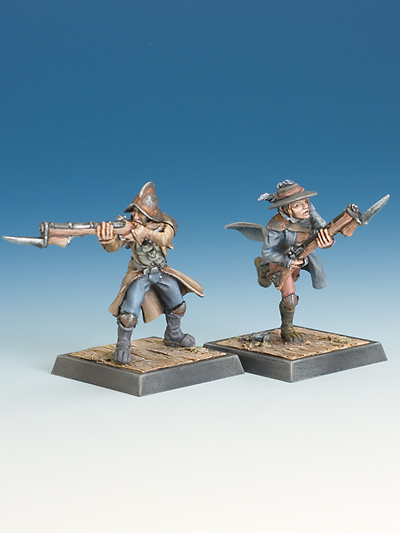
That's it for the Pirates and the Armada. Next time, I'll cover new crew for the Goblin Pirates and the Brotherhood, both of whom gain some cool new options,as well as the sole Mercenary made available in this book.
The Remaining New Units
Original SA post
Part IV: The Remaining New Units
Welcome back to this F&F of Freebooter's Fate: Deep Jungle . Last time, you heard about the new units available for the Pirates and Imperial Armada. Today, we'll be talking about the storyline advances and new units for the Goblin Pirates, the Brotherhood, and the sole Mercenary available.
The Goblin Pirates have had a good year. With the Empire's attention elsewhere and more goblins joining the fight against the Hairies, they've been gaining confidence in their plans, seeing some new blood in their ranks, and even permanently taking control of settlements and forts, rather than just raiding them. They're helped by their endless inventiveness – they've got some smart goblins among them, and they're always willing to let rumor do the work for them.
One new Leader is available for the Goblins – Chulo Bolu , a former slave whose owner was a rich merchant. Unlike most Goblins, he's taken to formal human education like a duck to water, and has managed to use these skills to lead a great crew. Possessed of a natural understanding for tactics, as well as noticing how the hairies tend to lose confidence in the face of the Goblin's crazier schemes, he's hoping to lead the Goblins to a new age where they're the ones in charge. Most of them tune him out when he starts talking all big and fancy, but they're impressed with many of his schemes have succeeded – the plan to free one of their fellow Goblins from the Cazador's grasp was his, as well as some other remarkable tactical wonders. Still, he's a young upstart, so most Goblins aren't too keen on following him.
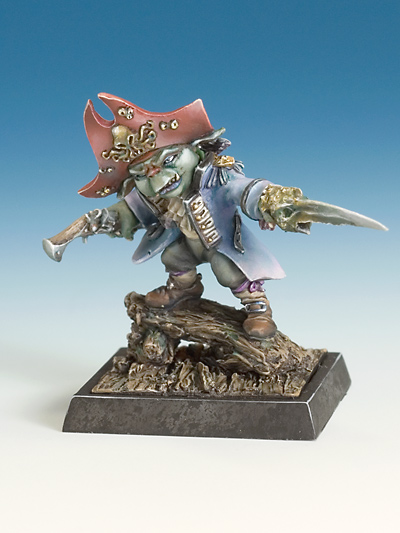
Death-fish!
Chulo Bolu is closer to a Pirate leader than a Goblin – he's fairly brave, skilled in melee and at range thanks to his various weapons, and is pretty good at making sure people follow his orders. In deference to the fact he's a Goblin, his ”sword” is a steel-coated swordfish, and he's still not quite sure how to act. Still, despite the prissy act, he's got one major factor that gets his fellow Goblins to listen to him – his mother.
The first Specialist for the Goblins in this book is Momma Galina . Rightly feared wherever her right hook reaches, she's a terrifying fighter and an even more terrifying cook. She's also Chulo Bolu's mother and, much to his chagrin, incredibly proud of him, taking every opportunity to show his baby pictures to anyone who can see, occasionally employing headlocks to ensure that they're paying attention. In the fiction introducing her, some poor Brotherhood assassin, having seen the danger of a charismatic Goblin, shoots Chulo Bolu. His mother doesn't like that one bit, and after beating him half to death and determining that her son was fine, shows the trapped assassin the baby pictures.
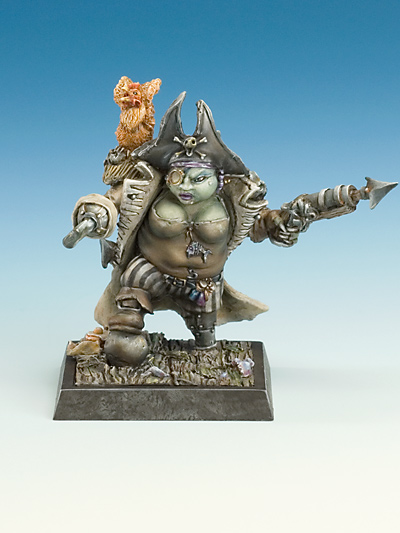
Basically just an overprotective mother. Y'know, with a gun and a propensity for violence.
Momma Galina is incredibly tough, taking a lot of damage to go down. She gets a morale bonus if she's on her son's crew, and – once per game – can switch places with him in a melee they're both in as she charges in to rescue her son. She's decent in close combat, but the real terror is her pistol – converted to fire arrows, rather than those prissy bullets. They fire in a straight line, passing through anyone unfortunate enough to be in the way. She's a damn great option for Goblin crews, and worth hiring even if you're not using Chulo Bolu.
El Charro and Pujamen really love the circus, and due to stupid hairy prejudice, always had trouble getting in. After a failed attempt to dress as children and enter due to having no grown-up there with them, they noticed some acrobats balancing on each other's shoulders. With the help of a long coat, they start imitating one of the hated hairies, with El Charro balancing on Pujamen, and after successfully beating up a few pirates, they saw the potential in the trick. Chulo Bolu saw it as one better, and they're the first spies that the Goblins have ever had, leading several successful infiltration missions.
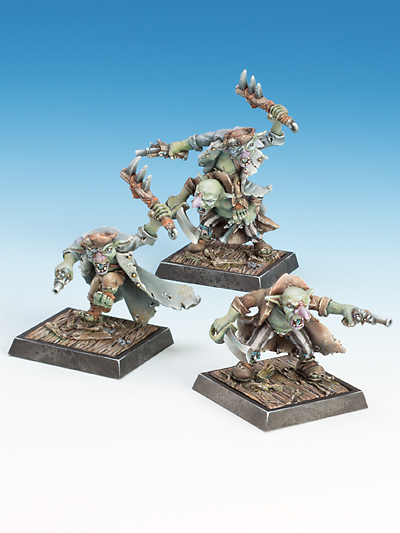
I love the piggyback model.
As specialists, you've always got to hire them together, but you get two Goblins for the price. They can piggyback on one another, which lets them reload quickly, act as one unit, and – best of all – dismount suddenly and outnumber an opponent in melee. They're pretty much identical in stats, aside from their chosen weapon – Pujamen has the scary knife, while El Charro has the scary club.
Grogg , also known as Senor G, is a big, burly goblin, well-known for both his size and his love of jewelry. Once a servant on a merchant's plantation, he learned all sorts of trade skills there – mostly involving blacksmithing and other household repair skills. When Chulo Bolu's crew was trapped by an Imperial squad in a warehouse with nothing more than assorted junk, he hit upon the idea of taking a barrel and using an old stove to construct some rudimentary armor. The squad, confused by the sounds of hammering, were even more confused when a barrel suddenly appeared. It grew even worse when the barrel turned out to be bulletproof and contained a goblin who was a damn good shot with a pistol. Ever since that day, Chulo Bolu has loved having the burly, gold-chain wearing Goblin as a member of his crew.
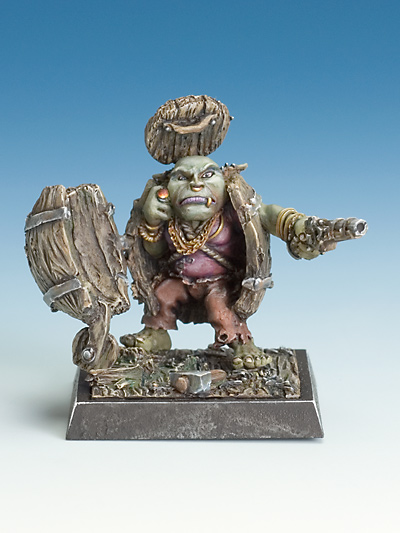
Me have low respec' fo' th' lughed stands in me way, innit?
Grogg loves his barrel – it's cover, armor, and a home, all in one. He can close the lid, rendering him into just another harmless barrel, untargetable by ranged combat and usable as cover for other Goblins. While he's not particularly great in melee, he's basically moving cover for the rest of the crew, and his toughness and barrel ensure he's hard to kill even if you can swing at him.
Finally, to make the joke obvious, Chulo Bolu's closing line in the story is, ”I am delighted when a scheme works out.”
The Brotherhood should have struck when the Empire was pushed out of Longfall – instead, they suffered thanks to the sudden loss of information networks, the well-regulated series of kickbacks that they once had, and the sudden changes in the system. Even worse, there's some infighting within them – some members want to take a more moderate view, operating openly, while others have even transformed parts into a far-ranging extortion agency. They've gained some more options here, so let's start with their Leaders .
Dottore is a well-known figure about town – known as Siringa, he's a dealer in medicines and a surgeon of no small skill, plagued by a series of long-running maladies and injuries that have nearly crippled him in his old age. He wears a leg brace, and is working on his masterpiece – Toccasana, a wonder-drug to ease pain, increase vigour, and keep someone going long after they should be dead. It's his life's work, and he sees the Brotherhood as another way to get access to research subjects for it. Much of the introductory story concerns his formulation process and experimentation – including several of the failures, such as Toccasana's unfortunate tendancy to cause a rather painful shock to the system and total paralysis in situations of high stress. The story ends with Fith'Arach, whose obsession with poison he finds disturbing despite the similar nature of their work, picking up some of it and doing that creepy thing where he talks to poison more than people.
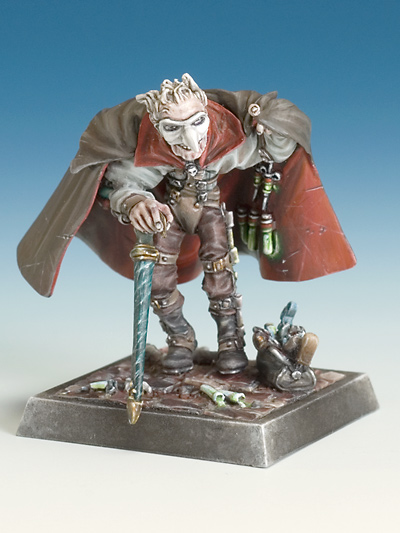
The pseudo-Plague Doctor mask works pretty well for the guy.
Dottore is an interesting leader for the Brotherhood – practically useless in combat, he's mostly good at healing wounds, poisoning weapons, and surviving if he's ambushed. Physically weak and with no ranged attack, he's a support leader more than anything else. He can also purchase doses of Toccasana, which can be used to buff his allies, but has a chance of injuring them every round. He can take it himself with no effect, which makes him a little more survivable, but it's not required.
As you might suspect, they gain several new Specialists this time around.
Colpo di Mano is the typical assassin, specializing in striking at night and through thick, obscuring fog. Although we don't learn too much about his character – aside from his obsession with concealment and fog – he's a valuable member of the Brotherhood, used for stealthy assassinations on the streets that no one should observe.
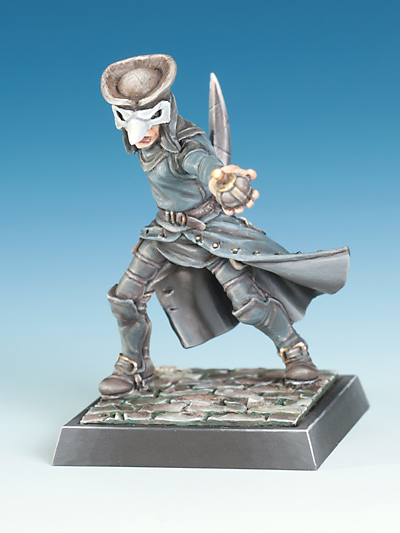
Fun fact – while uploading images for this review, I confused his model for one of the other Brotherhood assassins. They're not exactly distinct in design.
He's got the usual tricks of the basic model Brotherhood specialist – good at concealing himself, better when making a sneak attack, and poisoned knives. He's also got a once-a-game smoke bomb that creates moving concealment – he's immune to any penalties it imposes, and it lasts for a random amount of time, drifting around the battlefield. It makes ranged attacks fairly useless, thanks to blocking LOS, and it really helps to cover their weakness at range.
Adombra is the one the Brotherhood calls when they can't get close to a target. Her introductory fiction details one of her assassinations – the Comandante Esteban Cardoso, a naval inspector, whose presence had offended someone on the island. Here, the fact that no one in the Brotherhood really knows the reason behind half of their missions is made clear – she's got no idea who wants him dead and doesn't care, because her job is simply to be the best long-distance killer they've got. She gets her target, leaves, and that's all we learn about her.
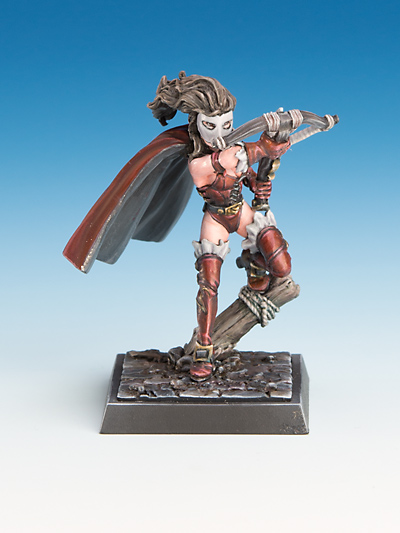
Holy shit, this sculpt. I can't even describe how much it annoyed me when I started putting it together. That outfit is goddamn ridiculous.
As a model, she's purely a ranged combatant, using a poisoned crossbow with nearly the range of a arquebus. She's got fast movement, is hard to pin down with ranged attacks thanks to getting a good defensive bonus from terrain, and her crossbow is pretty terrifying – unlike most weapons with its range, which take a complex action to reload, once she's in position, she can fire and reload in a single turn. That, plus the poison, means she's good at getting consistent damage at range – something the Brotherhood usually can't do.
Finally, we get the new Deckhand for the Brotherhood – the Battitore . Rather than being the stealthy murders that we're used to seeing, they're essentially the hired goons of the mafia, part of a growing faction within the Brotherhood that feels the Great Undertaking is a fool's errand and that they'd be better off charging protection money and using their connections for their own advantage. They're hard-hitting in melee, but have no ranged options. A good option to mix in with the Brotherhood's limited options for Deckhands, especially as they're cheaper than Harelequins.
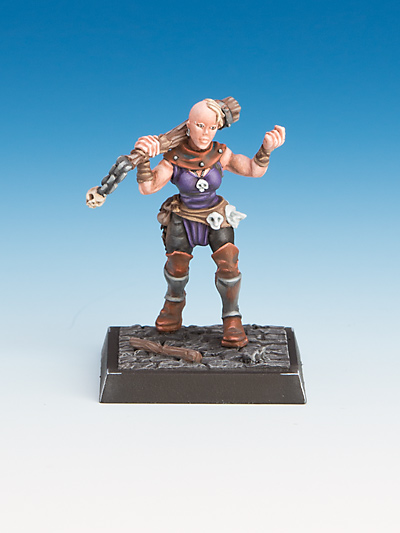
Battitore – note the little masks on the belt.
Finally, we have the sole Mercenary of the book – Fidanzata. The daughter of a prominent merchant, her life was once perfect – she was a celebrated beauty, and more than one handsome teniente in the Armada had fought a duel over her honour. That all came crashing down on her wedding day – searching for her new husband, she overheard her father and new father-in-law arguing over the price he'd been paid for her, and found her new husband in the kitchen, ”instructing” some of the comelier female servants. Something snapped, and she began wandering the streets, disfigured herself, and living out her life on the edges of society. But she'd found a friend in the gutters with her – Longfall's most numerous residents, the rats.
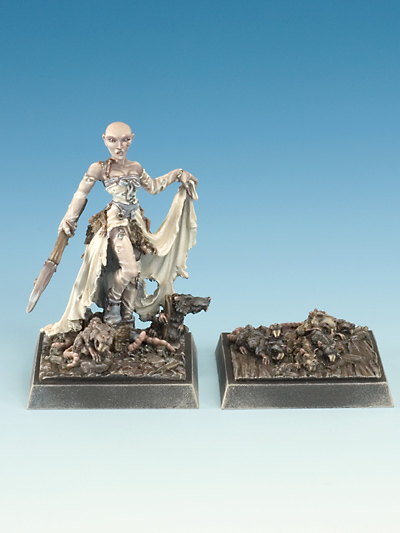
Fidanzata is another animal handler – instead of oncas, she can be hired alongside several swarms of rats. She's decent in melee thanks to poisoned weapons and a general unshakable courage, but her true strength comes from getting hordes of rats into melee with her – the Rat Swarms are individually weak, but quite fast, hard to hit, and can climb with no penalty.
That's it for the new units – next time, several new scenarios, as well as the rules to the first mini-campaign for Freebooter's Fate and my thoughts on this book.
Scenarios and Closing Thoughts
Original SA post
Part V: Scenarios and Closing Thoughts
Welcome back to the final part of this F&F of Freebooter's Fate: Deep Jungle Today, I'll be discussing the scenarios and mini-campaign presented in this book, along with my thoughts on what this particular expansion has added and what it says about the game. So, without further ado, let's talk scenarios.
The first one presented is In The Jungle . Your standard basic scenario, for variations for 2-4 players, it's the normal ”Fight the opposing crew” scenario. Similar to other ones, the sole difference between it and the one that was presented in the first book is the terrain – any space that's not occupied by specific terrain is counted as jungle. It's suggest that you add various bits of scatter terrain to represent this and make it clearer for the players. Kinda interesting, and a good way to set up the new terrain mechanics, but pretty easy otherwise.
The second scenario – and my favorite from this book – is Hunt the Dodo . Dodos, in the world of Freebooter's Fate, are exceedingly tasty, reproduce really damn quickly, and are shockingly stupid. The players set up in the various corners, and dodos are placed across the board. They automatically flee away from any loud noises that are close to them – including gunshots and any other dead dodo, and, should they run into an obstacle, immediately break their necks because dodos are really, really dumb. Players get glory points for panicking or taking opponents out of action, but also for collecting dead dodos. The book provides tokens, but they've also made some fine dodo miniatures. It's my favorite introductory scenario from this book, bar none.
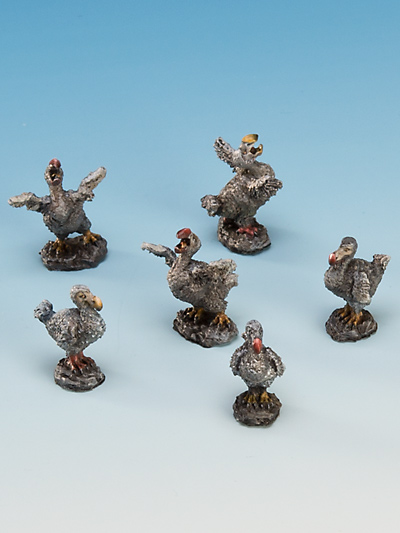
Here's the dodos they make. I love stupid bird miniatures.
Breakout is an interesting scenario, played with assymetrical sides. The attacker hires a full crew, while the defender hires a single miniature – either a leader or a specialist. The entire battlefield, being a jungle, is prone to mirages, so the defender also gets to place several tokens to represent their character. The attacker has to kill the defender's miniature, while the defender needs to get his mini through to the attacker's deployment zone. It's basically ”Predator: The Scenario”, especially considering the fact that the defender can re-deploy mirages when no one has LOS to them.
Man Raid is the first Amazon-specific scenario in the game, although it points out that the role of the attacker could be played by anyone if you can think of a good reason. In this scenario, a group of unarmed, drunken men (having heard some very fanciful tales about what the Amazons do to captured men; most of them unture and implying that they'll survive an enjoyable capture) are placed in the center of the board. Both sides need to capture the drunken idiots – the attacker is looking to use them for their nefarious purposes, while the defender is trying to get the idiots out of there. It's quite chaotic – some of the men aren't quite drunk yet, and the scoring is based on how easy it is to convince them to come with your crew – drunks head with the defenders, sober men head with the attackers.
Monsoon is another straightforward fight, meant to introduce a new terrain mechanic – weather. Because you're on a tropical island, it's raining incredibly heavily, and so ranged attacks have been made fairly useless – all ranges are reduced, as well as there being a chance that the rain has damaged your weapon in some way. While it's a little straightforward, it's pretty easy to add this to other scenarios; I'm not quite sure why it's here as a separate one, but it's a good way to add some changability to the game.
Now, we've got the real meat of Deep Jungle – the first mini-campaign in the game system. This is part of why I really like the game; they've prepared several related scenarios, each with rather unique victory conditions, that are all related to one another, providing rules if you're playing them as a campaign or simply as individual scenarios. It's quite clever, and it helps address the nature of this game as a sort of ”beer and pretzels” gaming system.
The Treasure of the Amayalli is the first mini-campaign, set up with a bit of fiction. The Imperial Armada is investigating why the Gobernador's astrologer has been missing for several weeks – when we join Teniente Matón, they've discovered that he'd been ambushed by goblins. All the evidence points to it – the scattered pages, the angles of the bulletholes, and the heap of dead goblins near the cart. Rifling through the remains, they discover that the Astrologer has been studying some of the ancient ruins and may have found the key to a great treasure. He's also been practicing the ancient language of the Amazons, using it to write several pickup lines in an attempt to charm them. Captain Rosso of the Pirates then arrives, having tailed the goblins in the hope of scoring some treasure. Just as they're planning to fight, a gust of wind picks up the scattered journal pages – each containing clues to the location of the treasure, and the hunt is on.
The Clue is the first scenario – players need to have their crew chase down the wildly fluttering scraps of paper as they're blown around by the sudden winds. Typical set-up, with all of the pages starting in a piece of terrain in the center – they suggest a broken-up cart, but anything works. Each page has a value on it – this will play into the upcoming scenarios. The mechanic for the wind is pretty simple – you can either randomly generate the direction of the wind using the Fate deck, or you can just blow gently on the table at the start of each turn. The winner is the one with the most clues at the end of the scenario.
Contact is the second scenario. It's introduced with a bit of intro fiction – mostly consisting of various pirates mangling the language of the Amazons and referencing Pratchett several times, but it gets the point across. This scenario involves trying to convince an Amazon to show them to the temple – she doesn't speak a word of the trade tongue, so it's up to the clues from the first scenario to give them any chance of speaking the language. A single Amazon is placed in the center of the board, moving randomly, and both sides need to convince her to join them. She's wary of both sides, and is unwilling to join anyone who is fighting while in her line-of-sight. It's a bit crazy at times – especially if she gets spooked and decides to flee or attack one of the sides. Winner is the one who convinces her to show them to the ruins.
Conquering the Amayalli is the final stage of the mini-campaign; it begins with some short fiction detailing what's going on here. The Goblin Pirates, successful in convincing Qualani the Amazon to show them the way, are excavating an ancient temple of the Amazons. Unfortunately, a heavy tropical storm is brewing, and the Goblins, in their haste, have accidentally damaged a small statue. This has some rather unfortunate consequences, especially when a group of Brotherhood assassins arrive. The scenario requires that a temple ruin be set up in the center – the defender, who is allied with the Amazon, set up on it, while the attackers can set up along the edges. The defenders need to dig up the center, taking care to excavate an exquisitely-crafted clay statue.
The site is a center of mystic power that doesn't like being disturbed, and so every turn, there's a chance that Qualani, the Amazon guide, is possessed by the spirit of a Jaguar and goes berserk, attacking anyone intruding on this sacred site. Her possession can be hastened if the diggers take too long or if the statue is damaged or broken. She turns into a horrific melee monster, killing pretty much everyone. Victory comes from keeping the attackers at bay (for the defenders), keeping Qualani from becoming possessed (again, defenders), or routing the diggers from the ruins. It's exciting, especially if you're running the whole campaign in a go, and can make for a cool mini game.
Closing thoughts
This was a good expansion – it's clarified a few of the rules that could use a little bit of work from the first book, added quite a bit of variation to the game, and has provided a ton of new scenarios for playing. It's also very good at introducing the concept of the mini-campaign and how to evaluate victory scenarios – in games like this, the goal should be on achieving objectives, rather than attacking the opponent and ignoring the point of the game, and it's easy enough to set up ways to have the results of the last game carry on to the next in a campaign. Admittedly, a lot of this comes from showing, rather than explaining how to do this design – comparing the various scenarios gives you a lot of detail on the design process.
It also adds something I think was incredibly useful – an index in the back that covers both books, to make looking things up a lot easier. It's an incredibly smart decision – especially with the push to make Traits as keywords rather than requiring explanations on every character card – and it helps a ton.
While I'm not a fan of all the designs in this book, and some of the sculpts are a little worse than those we've seen before, there's some good stuff here. I like quite a few of the Amazon's designs – they're appropriately tribal and show variation among individuals, which is pretty good – but some of the sculpts end up disappointing when translated from the art.
I would have liked to see more specific rules on campaign building, and perhaps an escalation mechanic for building a Crew, but there's more than enough here for anyone looking to add some variation for games. It's cemented into the “casual gaming experience” thanks to some of the goofiness of the scenarios and characters, but it's still a damn good game.
Assuming people are still interested in hearing about this weird little game, I'll work on getting a write-up ready for the next book in the series, Mystic Spirits , which introduces a wonderfully flavorful and thematic magic component to the game, brings in a new crew in the form of the Cult, and brings forward another mini-campaign. After that, I might cover the most recent release, Tales of Longfall #1 , a campaign book that covers the events of one night, giving five scenarios for players to play as either a campaign or as separate scenarios. Let me know if people are still enjoying this game – things get weirder from here on out.